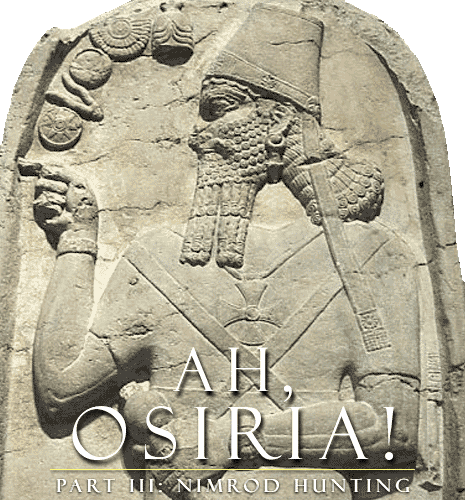
Editorial
|
Press Releases
|
Book Reviews
|
Fragments
Grand Canyon I
|
Giants III
|
Osiria III
Register
for our new Hall of Records Newsletter!
Questions? Comments? Suggestions? Advertising? Press Releases?
Contact us!
Part I: The Athenian Empire
|
Part II: Antediluvian Egypt
|
Part IV: Beast from the Sea
NEW!
Ah, Osiria! Discussion Board
(Requires Registration)
King Nimrod
|
Who Was Nimrod?
|
Nimrod Hunting
Osiria Links
|
Osiria Books
|
Osiria Audio
|
Osiria DVD
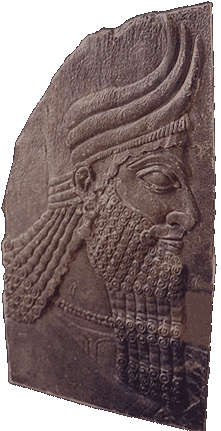
imrod, a mighty hunter before the LORD." Few words in the Bible have excited so much interest or speculation
as the brief passage in the
Table of Nations
of
Genesis 10
that describes a mysterious character known only as
"Nimrod".
Many have speculated on the true identity of this king, trying to match him up with numerous Assyrian, Babylonian, and even Egyptian kings. To this date, however, his true identity remains a mystery.
Nimrod, besides being a mighty hunter, was also known as both a conqueror and a builder of cities in the world after the Great Flood, in the eastern part of the region formerly known as
Osiria, now generally known as
the ancient Near East.
All over the ancient Near East — and perhaps throughout the entire world — legends state that Nimrod went far and wide conquering, and to conquer the barbarians that surrounded
ancient Mesopotamia
(modern Iraq)
on all sides, and building various cities in order to bring civilization to the face of the Earth. Thus, like
Osiris
of the Egyptian legends, he was the great civilizer of mankind, raising the standards of living for all under his domain
(map).
Yet, despite the positive aspects of his rule, the myths and legends that have circulated ever since about this mysterious king tell the tale of a man who also was possessed of a dark side. To be free of God's rule was his dark obsession, and in order to accomplish his dark purpose, he spoke dark sentences to enslave mankind to the ring of his dark will.

After the Great Flood, the descendants of Shem,
Ham
and
Japheth
spread out and multiplied over the face of the Earth as described in the Table of Nations (q.v.). The Table of Nations is essentially a simple listing of their descendants, with one exception: Nimrod, a descendant of Cush, the son of Noah, who rose head and shoulders above the rest to be the first great dictator of the post-Flood world:
8Cush was the father of Nimrod, who grew to be a mighty warrior on the earth.
9He was a mighty hunter before the LORD; that is why it is said, "Like Nimrod, a mighty hunter before the LORD."
10The first centers of his kingdom were Babylon, Erech, Akkad and Calneh, in Shinar.
11From that land he went to Assyria, where he built Nineveh, Rehoboth Ir, Calah
12and Resen, which is between Nineveh and Calah; that is the great city.
(Gen. 10:8-12), NIV.
This passage, though seemingly short, is in fact surprisingly long in context, being given an unusually large treatment in the otherwise extremely concise listing of the descendants of Noah. This has led many to believe that this man was considered to be truly exceptional not only in his time, but for many thousands of years afterwards, to the point where his ascent to power may have been a paradigmatic event of such magnitude that it had altered the course of human history forever. Moreover, some believe that one like Nimrod may rise again at the time of the end in a final attempt to conquer the world, so the identification of this mysterious character of the past may be critical to understanding our future and, possibly, our present.

|
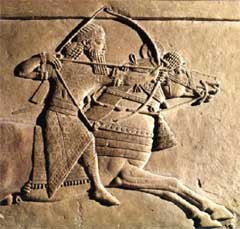
|
|
An Assyrian relief depicting a warrior engaged in battle. Mesopotamian kings were considered to be at least partly divine, and had to
prove themselves in battle either with a powerful opponent, or with a powerful wild animal, such as a lion. This tradition likely had
its roots in the traditions of kingship of Mesopotamia that had been laid down by the mysterious Nimrod thousands of years previously.
|
|
|
|
|
8Cush was the father of Nimrod, who grew to be a mighty warrior on the earth.
Scholars have long debated on this issue, particularly as to Nimrod's ancestry. King Nimrod ruled over the land of Mesopotamia, which was inhabited primarily by Semites, whereas the rest of Ham's offspring, including Cush, lived in Canaan, Egypt, North Africa and what is now southern Saudi Arabia. Perhaps instructive to this point is the etymology of his name. "Nimrod", many believe, has the root of the Hebrew word marad, "to make rebellion", which has led most scholars to agree with most of the myths and legends surrounding Nimrod that he was indeed the first to renew the rebellion against God in the world after the Flood. Part of this rebellion may have been his refusal to dwell in the lands alotted to the descendants of Ham, instead setting up his own kingdom apart from the authority of God, in a place of his choosing. Ignoring God's prime directive to "Be fruitful and increase in number; fill the earth and subdue it." (Gen. 1:28) — to spread over the entire face of the Earth — Nimrod instead centralized power in Mesopotamia in a bid for world supremacy, in an attempt to rule over mankind in God's stead as a self-appointed steward.
Along these lines, an interesting Sumerian text was discovered in the last century called
The Sumerian King List.
In this ancient text, there is a description not only of the early kings of Mesopotamia (all of the kings of
Sumer and Akkad
previous to Sargon), but also a list of the kings from before the Flood. Most importantly, this text describes how kingship had been "lowered from heaven", both before the Flood, and afterwards. Kingship had come deux ex machina not once, but twice. Like the biblical authors, who stated that "There were giants in the earth in those days; and also after that"
(Gen. 6:4),
the ancient Mesopotamians also recognized that the same deities who had brought civilization to
the world before the Flood
had brought it once again to
the world after the Flood,
starting in Mesopotamia, in the city of
Kish.1
This "Kish", and not the "Kush" listed as the forebear of Nimrod, may have been the true point of origin for Nimrod.
|
|
|
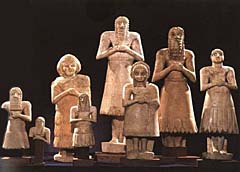
|
|
Sumerian votive statues of the Early Dynastic period (ca. 2800-2400 B.C.) These statues were left by worshipers at the altars of their
gods to pray on their behalf even when they were not physically present.
Click
here
to view similar lost treasures from the
Iraq Museum
courtesy of the University of Chicago's
Oriental Institute,
or go directly to the
Iraq Museum International
website.
|
|
|
|
Moreover, as we saw in
Part I
of "Giants in the Earth", one of the results of the descent of "kingship from heaven" — the fallen angels coming down to Earth and setting up kingdoms of their own apart from God's direct control — was
the manipulation of the human genome
in order to to create a race of giants that would conquer and exterminate God's own creation, homo sapiens. This race of giants, the
Nephilim,
was accompanied by a mixed-breed of giants and normal homo sapiens known as the
Gibborim,
or "mighty men", who were exceptionally tall, strong and warlike. This term, gibborim, "mighty men", is the same term used to describe Nimrod — "Nimrod, who grew to be a gibbor upon the Earth". Based on this, most commentators believe that Nimrod was in fact a giant, the first and most powerful of the new race of giants that the fallen angels were recreating in the world after the Flood. Thus,
the text of Genesis 10:8 may be amended to read:
"Nimrod, who was the first of a new breed of giants on Earth, came from Kish." And even though that emendation does answer some questions, it does not necessarily indicate an error in the textus receptus. The city of Kish could be
eponymous,
named after Kush, their ancestor.

|
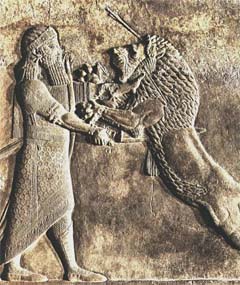
|
|
An Assyrian relief depicting a king finishing off a wounded lion. Depictions of kings in battle with lions are particularly common
in Mesopotamian art, and were designed to enhance the king's image as a powerful and virile conqueror.
|
|
|
|
|
9He was a mighty hunter before the LORD; that is why it is said, "Like Nimrod, a mighty hunter before the LORD."
Nimrod's marching orders from his fallen masters was to recreate the world as it had been before the Flood, which he did with great gusto. Like the giants of the antediluvian world, he was a superb hunter and warrior, so superior that his name became synonymous with military prowess, of the hunting of both man and beast. However, his true quest was not merely a glorious hunt for animals, or even the conquest of nations, but to uncover the past "glories" of the antediluvian world that had been destroyed and covered up by the Flood. These "glories", or technological achievements, would then be reused to rebuild the antediluvian world back to the level it had achieved before it had been destroyed by God's judgment. To this end, Nimrod's people abandoned their divinely allocated lands and instead made a beeline for the ancient cities of Babylonia that had been destroyed by the Flood, cities which in the world before the Flood may have been exceptionally technologically advanced. Tannehill explains, "Before this edict dividing the Earth, Nimrod, a descendant or son of Ham's son Cush [sic?] may have already become a noted leader and great hunter of wild beasts. He was the Caesar or Napoleon of his day and he led a rebellion against God's order to emigrate to Africa. The name "Nimrod" means rebellion. His people had emigrated but not where God afterward ordered them to go."2
It was there, in the city of
Kish
in ancient
Sumer,
that Nimrod apparently began his quest to uncover the antediluvian cities of the first generation of giants. He may have even uncovered ancient texts from the world before the Flood, leading him to make the oft-quoted statement, "I studied inscriptions from before the flood".3 Tannehill even goes as far as to say that Babylon, Akkad and all the cities of the land of Shinar had in fact been founded by Cain, "east of Eden", in the world before the Flood:
"Nimrod reinhabited the cities of Cain and adopted his language, his religion and his civilization. [They] built upon the ruins of a civilization that existed in Shinar before the Flood. This is exactly what the Babylonians themselves said. They glorified their ancient cities by ascribing to them a foundation in the ages before the Flood."4

|
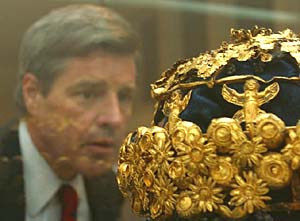
|
|
U.S. Embassador
to Iraq
Paul Bremer
gazes in awe upon a golden crown that had once been worn by ancient Babylonian royalty. The crown, along with numerous other
irreplaceable treasures, had been recovered from looters
and restored to its place in the
Iraq International Museum.
Click here
to view a comprehensive slideshow of the recovery, and of Bremer's visit to view the priceless artifacts.
|
|
|
|
|
10The first centers of his kingdom were Babylon, Erech, Akkad and Calneh, in Shinar.
Nimrod began his campaigns of conquest from his base in Mesopotamia, where he had apparently first begun his quest to uncover the world from before the Flood. Though the locations of Babylon amd Erech (Uruk, modern Warka) are both well known, having been rediscovered over a century ago, Akkad, though well attested in ancient literature, has yet to be found. Shinar and Calneh are even more difficult to identify, having no clear cognates either in archaeology or ancient literature.
Though there has been some debate5, Shinar is generally believed to be a variant spelling of
Sumer
(pronounced "shoo-mer"), whereas Calneh is generally believed to not be a city at all, but a phrase meaning "all of them", meaning that the three cities of Babylon, Erech and Akkad were all in the land of Shinar.6 van der Toorn and van der Horst explain,
The historical backdrop of the figure of Nimrod is furnished by an enumeration of cities either dominated or built by him. Most of the toponyms offer no problem to the interpreter: Babel (Akkadian: Babilu), Erech (Akkadian: Uruk), and Akkad all lie in southern Iraq, the heartland of the ancient Mesopotamian civilization. These three cities, each with historical roots well into the third millennium b.c., were part of what was known in cuneiform texts as "the land of Sumer and Akkad". The biblical text informs the reader that the three cities, "all of them" according to an an emendation of the Hebrew text supported by an ancient Samaritan interpretation, were to found in the "Land of Shinar". Other biblical texts make it clear that Shinar is a designation of Babylonia, that is, southern Mesopotamia.7
If Nimrod was indeed a mighty conqueror, it may even be that the term "all of them in Shinar" may not refer just to the preceding three cities, but to all of the cities in Sumer, of which Babylon, Uruk and Akkad were preeminent.
As such, Genesis 10:10 may be better translated as "His conquests began with Babylon, Uruk and Akkad, and then all of Sumer", a translation which fits perfectly with the description of Nimrod as a mighty warrior and hunter in the preceding verses — Nimrod was the first would-be dictator.
Commentators typically hold that Nimrod did not build the major cities of Sumer, but simply ruled over them, his major building activity being exclusive to Assyria, as described in verses 11-12. As we have seen, Babylon, Uruk and Akkad were likely the ruined remnants of cities from before the Flood that Nimrod had reoccupied and rebuilt, which is probably why he is not credited with founding them. As such, though we will probably not be able to determine when these cities were first built, if we can determine when they were rebuilt, it may help us in our search for the true identity of the mysterious Nimrod.
|
|
|
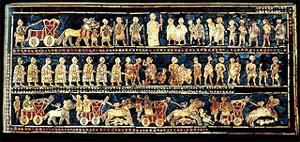
|
|
The "Standard of Ur," with lapis, shell and limestone inlays, 8" x 19", Ca. 2650 B.C.
The top panel shows soldiers leading prisoners of war to their king. Foot soldiers and charioteers make up the next two panels. In the fourth panel, the king is seated at the left while servants wait upon him and his banqueting guests. A harpist and singer at the right provide entertainment. The last two panels depict commoners in procession to the court. They bring livestock and the fruits of the land and sea as gifts for their royal master.
This "standard" provides a good general representation of life in Ur in
the mid-third millennium b.c. For this and more art of the ancient world, check out The Metropolitan Museum of Art's
Art of the First Cities
exhibit.
|
|
|
|
The first known culture in Sumer was the "The Uruk Culture", which rose around 3500 b.c. The Sumerians, who are believed to have emigrated to southern Mesopotamia from India and parts further east around 4000 b.c., had assimilated and intermarried with the native Semitic (Akkadian) populations who lived in the north of Mesopotamia to the point where, around 3500, b.c., the two groups were no longer clearly distinguishable. This mixed Sumerian/Akkadian population would form the cultural and ethnic basis for Mesopotamia for millennia afterwards, the kings of the region, starting with Sargon, routinely referring to themselves as "king of Sumer and Akkad".
However, though the culture is referred to as the "Uruk Culture", Kish was most likely the first of the cities to be resettled by Nimrod's people, as it is there that the Sumerian King List says that kingship was again brought down from heaven. Moreover, the first known writing comes from the city of Kish around 3500 b.c., which is important as the skill of writing was one of the gifts the fallen angels had given mankind that had led to their destruction by the Flood.8 Finally, the Bible also describes "Kush" or "Kish" as the "origin" of Nimrod. Thus, as Kish is described in the Sumerian King List as the place where kingship had come down from heaven again after the Flood, where writing first originated, and where the Bible places the origin of Nimrod, Kish ca. 3500 b.c. is the most likely setting for the rise of the mysterious Nimrod.
Economic documents that date to around 3200 b.c. show that Uruk rose in power as a rival to Kish, however, and indeed the Sumerian King List clearly states that though Kish was indeed where kingship had come down from heaven, that city was later abandoned first in favor of the city of Uruk and, still later, to Ur.
According to the King Lists, the first dynasty after the Great Flood (recorded in the
Gilgamesh Epic)
was the 1st Dynasty of Kish. The last two kings, Enmebaragesi and his son Agga, are the first rulers attested in contemporary inscriptions. According to the King List, �kingship� (namlugal) then passed to the 1st Dynasty of Uruk, which included Enmerkar, Lugalbanda, and Gilgamesh, heroes of epic tradition, and finally to the 1st Dynasty of Ur. Epigraphic evidence, however, shows that these dynasties (and a dynasty at Mari) were all contemporary and date to c. 2700�2600 B.C.E. Many rulers known from contemporary inscriptions are not found in the King Lists.9
Clearly, there have been many potential Nimrods in the history of Mesopotamia, so we will need to analyze the biblical and related data further in order to narrow down the list and find the true Nimrod. The Bible mentions that the beginning of Nimrod's kingdom was Babylon, Uruk, and Akkad, information which provides parameters of time that may help us determine the true identity of Nimrod.
Akkad, for example, is believed to have been built by Sargon I ("the Great") who reigned between 2371�2316. If Akkad indeed did not exist before that time, then Nimrod could only be Sargon, or some later king. However, the Akkadians as an ethnic entity existed as far back as 3500 b.c., so the city of Akkad was more likely rebuilt by Sargon, rather than founded. The time in which Babylon was founded is unknown, but it was in existence during the time of Sargon as well. We know this as Sargon's daughter, Enheduanna, priestess of the moon god in
Ur,
had written songs in praise of the temples of
Babylonia
during the time of Sargon, ca. 2350 b.c. Uruk, of course, was in existence at least as early as 3500 b.c., so we can date Nimrod back at least as far back as that time as well.

|

|
|
"The Golden Helmet of King Mes-Kalam-Dug". Some date this helmet to 2450 b.c., but others, such as Wooley, date it back as far as
3500 b.c. This was one of the irreplaceable treasures that had been recovered from looters and restored to its place in the
Iraq International Museum.
Click here
to view a comprehensive slideshow of the recovery.
|
|
|
|
|
11From that land he went to Assyria, where he built Nineveh, Rehoboth Ir, Calah
12and Resen, which is between Nineveh and Calah; that is the great city.
Unfortunately, though it has uncovered some interesting information, our analysis of verse 10 has not added any information that narrows the field of inquiry into the true identity of Nimrod. Fortunately, verses 11-12 supply more information. After he had conquered and consolidated Sumer, Nimrod then turned his eyes northward to Akkad. Though it is not explicity stated, in order to have the ability to construct cities in Akkad (later
Assyria),
Nimrod would have to have conquered that region first. Therefore, Nimrod did not simply travel to the region as a benevolent architect — he came as a conquering king, taking over and becoming absolute dictator of both Sumer and Akkad.
Having conquered and controlled all of Sumer and Akkad, Nimrod then embarked upon an ambitious building program. Not satisfied with merely rebuilding the past, he wanted to determine the future, and make a name for himself in the process. Perhaps that is why Moses did not give his true name, and left his fame purposely obscure — by naming him by name, and giving a more thorough explanation of his feats, Moses would have aided this wicked would-be dictator in his goal of making his name last forever in history.
Unfortunately, the material in verses 11-12 is as obscure as those in verse 10, if not more so. Not only are some of the place names obscure, it is debatable whether or not Nimrod is even being spoken of in these verses. Some believe that the verb yatsa, "to go forth", is actually the name of "Assur", one of the sons of Shem, which is why the KJV differs here. This makes some sense, as the Assyrians were indeed the descendants of Asshur. However, in context, it is clear that Nimrod is implied, particularly since the Nimrod passage is inserted into the list of the descendants of Ham, and not the list of the descendants of Shem.
After he had conquered and consolidated Akkad with Sumer, Nimrod embarked upon an ambitious building program. The cities he built are typically enumerated as "Nineveh", "Rehoboth Ir", "Calah" and "Resen".
|
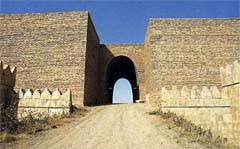
|
|
The Masqah Gate of Nineveh. Formerly Assyria, Nineveh is now located in northern Iraq. Nineveh once a vast, sprawling center of commerce that extended for miles and encompassed several cities.
|
|
|
|
|
|
|
 Nineveh:
Nineveh:
Nineveh
is easily identified, having been one of the greatest cities of the ancient world. Nineveh had been settled as early as 6000 b.c., and had been continuously inhabited as late as the 16th century.
 Rehoboth-Ir:
Rehoboth-Ir:
Rehoboth-Ir
is another city whose origin (or even existence) remains an "open" question. Hamilton explains,
Rehoboth-Ir
is not identifiable. Heb. rehobot means "open space" and ir means "city". Comparison may be made with Assyrian rebit ali, "open spaces in a city, unbuilt area", and specifically with rebit Ninua, "unbuilt areas of Nineveh". Is the reference here to peripheral sections of the city of Nineveh rather than to a separate city? Rehoboth may be taken as an adjective in the plural construct bound to a noun in the (collective) singular, to express a superlative. The meaning of Rehoboth-Ir is then "the widest city", in reference to Nineveh.... Possibly it was part of the sprawling urban complex around Nineveh.10
Rehoboth-Ir is most likely meant to be used adjectivally, describing how very large, wide and open Nineveh was. Nineveh was indeed a huge, cosmopolitan city and a major center of commerce and industry for the region. One gets the idea from this and other passages in the Bible — such as the description in Jonah that Nineveh was so huge, that it took three days to pass through the city
(Jonah 3:3) —
that Nineveh was an extremely spread-out, "open" area which was packed full of traders, merchants and businessmen from all over the world. So the addition of the adjective "Rehoboth-Ir" is totally appropriate, as Nineveh was indeed an exceptional city of the ancient world.
 Calah:
Calah:
Calah is to be identified with the Assyrian city of Kalhu, or modern Nimrud.11 Calah/Nimrud is located just a few miles southeast of Nineveh, and was likely part of a larger trading region centered at Nineveh. The meaning of the name is obscure, but it may have been meant to be the Akkadian/Assyrian equivalent of Babylon in the north, as the name can also be translated as "Holy Gate" or "Gateway of God":
"The name of one of the great cities of Nimrod.... The meaning of the name is unknown, but if a Sumerian etymology be accepted, some such signification as "Holy Gate" (Ka-lah) or the like — a parallel to Ka-dingira = Bab-ili, "Gate of God" — might be regarded as possible".12
Calah may have been Nimrod's attempt to create his own Babylon in the north, to equate himself with the giants of the antediluvian world who had created Babylon.
 Resen:
Resen:
Resen is another difficult city to locate. Some have suggested that there was a misspelling in the Hebrew text, where the Hebrew letter "d" was replaced by the very similar Hebrew letter "r", turning "Desen" into "Resen" As such, commentators have suggested that it refers to "Dur-Sharrukin, the administrative city founded by Sargon II, halfway between Nineveh and Kalhu to the north."13 Another possibility is
Res-eni, "fountainhead." "The only town so named in the inscriptions is one of 18 mentioned by Sennacherib in the Bavian inscription as places from which he dug canals connecting with the river Khosr — in fact, it was one of the sources of Nineveh's water supply. It probably lay too far North, however, to be the city here intended."14
These explanations are weak, and solutions can be found without amending the text. The best explanation is probably the ruins at Selamiyeh, once known as "Larissa".
As the Biblical text requires a site lying between Nineveh and Calah (Kouyunjik and Nimroud), it is generally thought to be represented by the ruins at Selamiyeh, about 3 miles North of the latter city. It is noteworthy that Xenophon (Anab. iii.4) mentions a "great" city called Larissa as occupying this position, and Bochart has suggested that it is the same place. He supposes that when the inhabitants were asked to what city the ruins belonged, they answered la Resen, "to Resen," which was reproduced by the Greeks as Larissa. Xenophon describes its walls as being 25 ft. wide, 100 ft. high, and 2 parasangs in circuit. Except for the stone plinth 20 ft. high, they were of brick. He speaks of a stone-built pyramid near the city — possibly the temple-tower at Nimroud.15
Resen also was once a substantial city, the third of a triad of cities that made up the larger trading network composed of Niveveh, Calah and Resen.
All together, the three cities that Nimrod built in Akkad/Assyria appear to have formed a vast trading area, a "greater Nineveh", which no doubt was the center of trade of the ancient world. Moreover, their construction may have been meant to mirror the three major cities of Sumer, Babylon, Uruk and Akkad, that Nimrod had inherited from his spiritual ancestors, the giants from the world before the Flood. Nimrod, attempting to recreate that lost world, spared no expense in the attempt, motivated by pride to make a name for himself that would live forever. Though he has long since passed from the world stage, his great city of Nineveh outlasted Akkad and even Assyria, being inhabited well into the Moslem period and almost into modern times. Moreover, with the freeing of Iraq, the ancient lands of Sumer and Akkad are free once more to become great centers of commerce. Interestingly, our translation of Genesis 10:11-12, where Nineveh and its surrounds are seen as forming "the great city", may be a clue to a similar role for this region in the end-times.

|
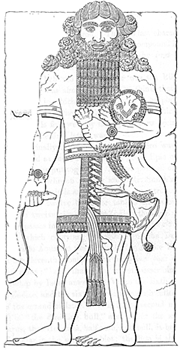
|
|
"Izdubar Strangling a Lion." Izdubar, or "Gilgamesh", was the archetypal divine king, one of the first kings of Sumer, ca. 3500 b.c.,
Gilgamesh
claimed to be "two-thirds divine", a demigod whose lineage was mostly divine, and he was also considered to be a
giant,
as is shown in this sculpture. Also an archetype of the later Heracles/Hercules of Greek myth, Izdubar/Gilgamesh is the most likely source of the Nimrod legend though others, such as Sargon, and even some deities, are close contenders. Interestingly, the approximate height of the figure in this sculpture is a
giant
at close to twenty feet, based on the relative size of the
lion.
Image from
The Chaldean Account of Genesis.
|
|
|
|
|
A mass of legendary and rabbinical material surrounds Nimrod, most of it speculation based on deduction and wordplay. Nimrod is variously associated with Cain, Terah, Abraham and other biblical figures, much in the same way that the rabbinical literature had made
Og
a participant in many of both the pre-Flood and post-Flood events of the Bible. In the literature, "Nimrod is the prototype of a rebellious people, his name being interpreted as 'he who made all the people rebellious against God' (Pes. 94b; comp. Targ. of Pseudo-Jonathan and Targ. Yer. to
Gen. x. 9)....
As he was the first hunter he was consequently the first who introduced the eating of meat by man. He was also the first to make war on other peoples (Midr. Agadah to
Gen. x. 9)."16
Nimrod was the first to do many things, including hunting, eating meat, and making war, and was generally portrayed as the originator of everything in society that goes against
God's will for mankind.
Yet, according to the traditions, he was not always that way.
Nimrod was not wicked in his youth. On the contrary, when a young man he used to sacrifice to YHWH the animals which he caught while hunting ("Sefer ha-Yashar," section "Noah," pp. 9a et seq., Leghorn, 1870). His great success in hunting (comp.
Gen. x. 9)
was due to the fact that he wore the coats of skin which God made for Adam and Eve
(Gen. iii. 21).
These coats were handed down from father to son, and thus came into the possession of Noah, who took them with him into the ark, whence they were stolen by Ham. The latter gave them to his son Cush, who in turn gave them to Nimrod, and when the animals saw the latter clad in them, they crouched before him so that he had no difficulty in catching them. The people, however, thought that these feats were due to his extraordinary strength, so that they made him their king (Pir-e R. El. xxiv.; "Sefer ha-Yashar," l.c.; comp. Gen. R. lxv. 12)....
According to another account, when Nimrod was eighteen years old, war broke out between the Hamites, his kinsmen, and the Japhethites. The latter were at first victorious, but Nimrod, at the head of a small army of Cushites, attacked and defeated them, after which he was made king over all the people on earth, appointing Terah his minister. It was then, elated by so much glory, that Nimrod changed his behavior toward YHWH and became the most flagrant idolater. When informed of Abraham's birth he requested Terah to sell him the new-born child in order that he might kill it (see Jew. Encyc. i. 86a, s.v.
"Abraham in Rabbinical Literature").
Terah hid Abraham and in his stead brought to Nimrod the child of a slave, which Nimrod dashed to pieces ("Sefer ha-Yashar," l.c.).17
Generally speaking, despite attempts of commentators to give his image a degree of humanity, for the most part Nimrod was described in the rabbinical and legendary material to be the very paragon of arrogance, self-righteousness and rebellion against God.
Josephus
weighs in on the subject thusly:
"Now it was Nimrod who excited them to such an affront and contempt of God. He was the grandson of Ham, the son of Noah, a bold man, and of great strength of hand. He persuaded them not to ascribe it to God, as if it was through his means they were happy, but to believe that it was their own courage which procured that happiness. He also gradually changed the government into tyranny, seeing no other way of turning men from the fear of God, but to bring them into a constant dependence on his power...."18
We have heard about how Nimrod encouraged men to rebel against God, but now we understand why — so that Nimrod could rule over mankind in the place of God. Nimrod's encouragement of man to rebel against God was not in their best interests, only in his own. Putting himself in the place of God, he made an idol out of himself, cursing God and disobeying his laws, even those that had God had given to his ancestors. Coveting the land of Shinar, he stole it from those to whom it had been given, and murdered those who opposed him. He then taught men to do the same, to abandon marriage in favor of adultery, and lying in favor of truth, so as to maximize their ability to pursue personal power and glory. He then spoke out against God and his divine laws, giving his subjects unbridled freedom and the ability to pursue happiness and self satisfaction. Afterwards, after this philosophy had — predictably — led to anarchy, Nimrod then enslaved the morally weakened and divided peoples, replacing the fear of God with the fear of himself. This "divide and conquer" approach was to be the hallmark of his rule and that of his descendants from that time onward, even unto the time of the end.
Though we have examined the legendary material for additional clues as to the true identity of Nimrod, and have concluded that Nimrod's method of rebellion from God and establishment of his rule over Earth was through the total abandonment of God's times and laws, we have yet to determine exactly who in history was the infamous Nimrod. And the candidates are numerous, though a few tower above the rest:
Two prominent theories are now held in regard to Nimrod's identity: one, adopted by G. Smith and Jeremias, is that Nimrod is to be identified with the Babylonian hero Izdubar or Gishdubar (Gilgamesh); the second, that of Sayce,Pinches, and others, identifies Nimrod with Marduk, the Babylonian Mercury. The former identification is based on the fact that Izdubar is represented in the Babylonian epos as a mighty hunter, always accompanied by four dogs, and as the founder of the first great kingdom in Asia. Moreover, instead of "Izdubar"�the correct reading of which had not yet been determined�Jeremias saw the possibility of reading "Namra Udu" (shining light), a reading which would have made the identification with Nimrod almost certain. Those who identify Nimrod with Marduk, however, object that the name of Izdubar must be read, as is now generally conceded, "Gilgamesh," and that the signs which constitute the name of Marduk, who also is represented as a hunter, are read phonetically "Amar Ud"; and ideographically they may be read "Namr Ud"�in Hebrew "Nimrod." The difficulty of reconciling the Biblical Nimrod, the son of Cush, with Marduk, the son of Ea, may be overcome by interpreting the Biblical words as meaning that Nimrod was a descendant of Cush.
Two other theories may be mentioned: one is that Nimrod represents the constellation of Orion; the other is that Nimrod stands for a tribe, not an individual.19

|
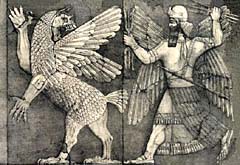
|
|
A depiction of the ancient Sumerian creation epic, wherein the creation of the heavens and the earth was viewed as the result
of a battle between the high god of the Sumerian pantheon (originally Anu, then Enlil, later Ninurta, Marduk, Asshur)
and a dragon named "Tiamat". This depiction appears to a later version where the god Marduk was credited as the defeater of the dragon
and creator of the heavens and Earth. Marduk, a mighty warrior god, may have been the prototype for the biblical Nimrod.
|
|
|
|
|
Most commentators assume that Nimrod was a man — a long-lived, superior physical specimen of a man, gigantic in stature and in personal charisma.
One possibility that most commentators overlook, however, is that Nimrod may not have been a man, but a deity. The ancient Mesopotamians tended to idolize figures who were powerful hunters, warriors, and leaders, and as such, their gods tended to reflect these attributes. Moreover, the long span of time indicated by the accomplishments of Nimrod in the Bible leads some to suggest that, since most human kings reigned for less than 50 years, 60 at most, either Nimrod had a supernatural longevity, was a particularly successful politician, or the biblical writers may have had one of the false gods of Babylon in view. "If Nimrod is not a god, he must at least have enjoyed a divine longevity."20 And though there are candidates on the list that fit either of the other two criteria — unusual longevity and political prowess — the Babylonian Deity theory has its merits.
And of these gods, two have stood out in the history of Mesopotamia as "mighty hunters" and "builders of cities": Ninurta, and Marduk.
 Ninurta:
Ninurta:
To our knowledge, Ninurta is first referred to in a Sumerian composition known as
"LUGAL-E".
In this epic poem, Ninurta is described as a king, and a storm "whose radiance is princely". He is also described as "a hero striding fiercely into battle". In this and many other epic poems, Ninurta is seen slaying a variety of frightful creatures, including a giant eagle, a lion, a seven-headed serpent, a six-headed boar, a bison, a seven-headed hound, and a buffalo. Some commentators have even pointed out the numerous points of commonality between the "feats of Ninurta" and the labors of Hercules, indicating that the Greek and Roman Hercules myths may have been adopted from Mesopotamian sources. "Judging by the mythological exploits of Ninurta, then, there is every reason to call him a 'mighty hunter'. By virtue of his mythological career, Ninurta became the patron of hunters. The neo-Assyrian kings, who liked to boast of their hunting prowess, refer to him as their source of inspiration. Thus Tiglath-Pileser I writes that he went hunting for bulls, elephants, lions and birds 'at the command of Ninurta who loves me'."21
Moreover, like Nimrod, Ninurta was known for his organization and civilization of Mesopotamia, including the creation of the Sumerian water system, which formed the basis of their agricultural system and, thus, their economy. And though he was not explicitly credited for building it, the city of Calah, mentioned in the Bible as having been built by Nimrod, was a major cult center for Ninurta. And since Calah is an Assyrian city, Ninurta can be seen as having moved from Sumer north to Assyria, as Nimrod had done. Ninurta, then, is an excellent candidate for the mysterious Nimrod, as "Nimrod (Ninurta) is the archetype of the Babylonian deity, a symbol of Mesopotamian civilization."22
|
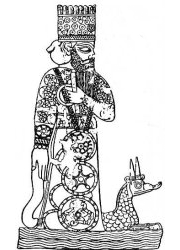
|
|
Marduk, god of Babylon, and one possible contender for the mysterious Nimrod.
|
|
|
|
|
 Marduk:
Marduk:
Another Mesopotamian deity popular in its time was the god
Marduk.
Marduk was also known for destroying the dragon Tiamat and her brood of monsters in the Babylonian Creation Epic, also known as
Enuma Elish.
In this same epic, Marduk is depicted as having built the city of Babylon making him, unlike Ninurta, a true builder of cities. Marduk worship, like that of Ninurta, also moved north into Assyria, so that parallel is present as well. Moreover, "the signs which constitute the name of Marduk, who also is represented as a hunter, are read phonetically "Amar Ud"; and ideographically they may be read 'Namr Ud'�in Hebrew 'Nimrod'."23
Perhaps most important is the close similarity of Marduk with the earlier Ninurta, who was also the hero god of an earlier creation epic, the LUGAL-E, which was similar to Enuma Elish in many respects:
The motif of a mythological battle between a heroic god and an army of monsters was not invented by the author of the Babylonian Creation myth. On the contrary, in the literary history of Mesopotamia the topos of the divine combat occurs as early as the third millennium b.c. In a number of these compositions it is the god Ninurta who is the monster slayer. When this role is conferred upon Marduk in Enuma Elish, the mythological feats traditionally ascribed to Ninurta become accomplishments of the city god of Babylon. This reinterpretation of an ancient theme is a piece of religio-political propaganda. But turning Marduk into a Ninurta redivivus, the Babylonian theologians underscored the preeminence of their god, whose triumph had to match the leading position of their city.24
The character of Nimrod, then, may not have been a man at all, but a Babylonian deity who was considered to have been present at the foundations of all of the cities in both Sumer and Akkad. Both seen as mighty warriors and civilizers, Ninurta, Marduk and other lesser Mesopotamian deities may represent a tradition that was unique to Mesopotamian history. And since no one king or even one god ever ruled for the whole of Mesopotamian history, Moses may have decided to give this "king" the generic name of "Nimrod", just as he done with the term balal, "confusion" used to describe the Tower of Babel in
Genesis 11.
In this way, he also avoided mentioning the name of a foreign god in the text, which would have broken the first commandment.

|
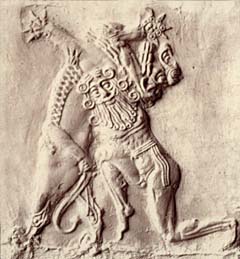
|
|
Izdubar (Nimrod) in Conflict with a Lion. Izdubar is generally considered to be the same character as Gilgamesh, a mighty hero/king of
Sumer ca. 3500 b.c. who had been known for his feats of strength and defeat of numerous dangerous creatures. Deified after his death, Gilgamesh was a major figure in Mesopotamian myth and legend for millennia.
|
|
|
|
|
Though Ninurta and Marduk are good candidates for the mysterious Nimrod, by far the best candidate is the ancient hero/king Izdubar, more commonly known as
"Gilgamesh".
Gilgamesh was the king of Uruk, the biblical "Erech", and was believed to have been given the secret knowledge of the world before the Flood by the gods. As we have seen, according to
The Sumerian King List,
after the Flood kingship had been lowered from heaven once more, in the city of Kish, in ancient Sumer. According to the list, since kingship had been lowered from heaven to Kish after the Flood, "Twenty-three kings ruled it for 24,510 years, 3 months and 3-1/2 days".24 After that period of time, which is probably inaccurate, Kish was defeated in battle, and the kingship of Sumer had been moved to the city of Uruk. There, Gilgamesh was the fifth king in a line of 12 kings that lasted for 2,310 years until Uruk had been defeated in battle and the kingship removed to the city of Ur.
The actual date for the founding of the city of
Uruk
was likely around 3500 b.c., a date which archaeologists have fixed with a fair amount of certainty. It was during this time that "the Uruk Culture" arose in Mesopotamia, setting a high water mark of intellectual and cultural achievement that all the civilizations to follow in the region for thousands of years would look back to as the "golden age" of Sumer. It was in Uruk, ca. 2700 b.c. where Gilgamesh ruled as both priest and king, being both a wise ruler and an understander of mysteries:
He who has seen everything, I will make known to the lands.
I will teach about him who experienced all things,
Anu granted him the totality of knowledge of all.
He saw the Secret, discovered the Hidden,
he brought information of the time before the Flood.
He went on a distant journey, pushing himself to exhaustion,
but then was brought to peace.
He carved on a stone stela all of his toils,
and built the wall of Uruk-Haven,
the wall of the sacred Eanna Temple, the holy sanctuary.
Look at its wall which gleams like copper,
inspect its inner wall, the likes of which no one can equal!
Take hold of the threshold stone — it dates from ancient times!
Go close to the Eanna Temple, the residence of Ishtar,
such as no later king or man ever equaled!
Go up on the wall of Uruk and walk around,
examine its foundation, inspect its brickwork thoroughly.
Is not even the core of the brick structure made of kiln-fired brick,
and did not the Seven Sages themselves lay out its plans?
One league city, one league palm gardens, one league lowlands, the open area of the Ishtar Temple,
three leagues and the open area of Uruk it (the wall) encloses.
Find the copper tablet box,
open its lock of bronze,
undo the fastening of its secret opening.
Take and read out from the lapis lazuli tablet
how Gilgamesh went through every hardship.
— The Epic of Gilgamesh (Tablet I, Lines 1-27)26
There are many versions of old Izdubar/Gilgamesh legends, most of them in fragments. In all of them, however, Gilgamesh is seen as a mighty hunter, warrior, and seeker of ancient mysteries. A highly intelligent, gifted, and divinely guided man, Gilgamesh bragged of being 2/3 god and 1/3 man, a giant in stature both in thought, word and deed. For obvious reasons, many critics have pointed out that these legends are very similar in nature to the text in Genesis that describes Gilgamesh. As Smith explains,
The centre of the empire of Izdubar is laid in the region of Shinar, or Sumir, Erech, "the lofty" being the chief seat of his power, and thus agrees with the site of the kingdom of Nimrod, according to Genesis.... We cannot overlook the fact that the character of Izdubar as hunter, leader and king, corresponds with that of Nimrod.... Izdubar, moreover, agrees exactly in character with Nimrod; he was a hunter, according to the cuneiform legends, who contended with and destroyed the lion, tiger, leopard, and wild bull or buffalo, animals the most formidable in the chase in any country. He ruled first in Babylonia over the region which from other sources we known to have been the centre of Nimrod's kingdom. The principal scene, too, of his exploits and triumphs was the city of Erech, which, according to Genesis, was the second capital of Nimrod.27
As we have seen, at least one scholar has translated the ancient symbols that make up the name "Izdubar" to read "Namr Ud", "Shining Light".
Smith also points out that Izdubar was also specially connected to the town of "Marda", the original Akkadian name of which was "Amarda". In Akkadian, the word for "god" is "an", and put together with "Amarda", it becomes "Anamarda", which is very similar to the name "Nimrod" ('Ni-mar-a-da). Moses would not have wanted to give Gilgamesh fame in the Bible, though, even though he was only a demigod, placing his name in the Bible also would have violated the first commandment. Therefore, it is likely that Moses substituted "Gilgamesh" with "Nimrod" — a generic term meaning either "shining light", "he from Marad", or perhaps another translation that as yet eludes us.
Thus, Izdubar/Gilgamesh fits the description of Nimrod both in name and in fame. However, though Gilgamesh did rule Uruk, one the cities mentioned in the Bible as part of Nimrod's kingdom, he was not known for being a conqueror, merely an adventurer and a seeker of mysteries. Moreover, there is no mention in the myths of Gilgamesh having built the cities of Nineveh, Resen, and Calah, which Nimrod had been credited with. These cities were reserved for our next candidate: Sargon the Great, King of Sumer and Akkad.

|
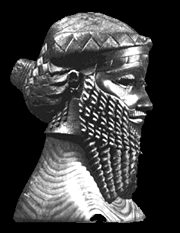
|
|
Sargon I "The Great", King of Sumer and Akkad ca. 2334-2279 b.c. Sargon is one of the best candidates of all the human kings for being
the mysterious Nimrod.
|
|
|
|
|
Though Gilgamesh best describes Nimrod in his aspect of mighty hunter, mighty warrior, and ruler of Sumer, later Sumerian, Akkadian, Babylonian and even Assyrian kings better fulfill the description of Nimrod as a conqueror. And of all of the kings of Sumer, Sargon was the first to become a true conqueror, conquering all of the city-states of Sumer and
Akkad
and creating the first true empire.
 Sargon:
Sargon:
The Sumerian king list gives a number of kings whom it claims ruled for thousands of years, and then ends just before Sargon. Sargon then takes the stage in the 23rd century b.c., defeating Lugalzaggisi, the king of Uruk, and dragging him away in a dog collar in order to humiliate his former master and literally bring him to heel. This sort of radical action, intended to strengthen his own image as a mighty conqueror who is not to be trifled with, seems unusually cruel and disrespectful even for a conquering king.
The picture that emerges in the stories and legends surrounding Sargon's rise and rule is one who "breaks the mold" of the old traditions of Sumer, establishing new rules for himself and his glory perhaps more so than any other king previous to him. He even ascribed to himself divine parentage, and a life that was charmed, guided by the gods towards greatness. This attitude is particularly evident in "The Legend of Sargon":
Sargon, the mighty king, king of Agade, am I.
My mother was a changeling, my father I knew not.
The brothers of my father loved the hills.
My city is Azupiranu, which is situated on the banks of the Euphrates.
My changeling mother conceived me, in secret she bore me.
She set me in a basket of rushes, with bitumen she sealed
My lid.
She cast me into the river which rose not (over) me,
The river bore me up and carried me to Akki, the
drawer of water.
Akki, the drawer of water lifted me out as he dipped his
ewer.
Akki, the drawer of water, took me as his son
and reared me.
Akki, the drawer of water, appointed me as his gardener,
While I was a gardener, Ishtar granted me (her) love,
And for four and [ ... ] years I exercised kingship,
The black-headed people I ruled, I governed.28
Not of royal Sumerian blood, Sargon was actually a Semite, of the Akkadians who were the neighbors of the Sumerians to the north. His mother is described as a "changeling", a term which in English means that she, or perhaps Sargon himself, or both, had been placed in their mother's wombs by divine parents. Thus, by including this term, Sargon was ascribing to himself divine parentage, making himself, like Gilgamesh before him, a mighty man and son of the gods. Sargon's description of himself as having been set upon the water in a reed basket is also interesting, as the description of his watery journey is very similar to the early experience of Moses. Though the two men are clearly different, separated by thousands of miles and at least a thousand years, this description has incited no small amount of speculation on its own.
Raised by a poor "drawer of water", Sargon was then granted good fortune by Ishtar, whom he believed placed him in the right place at the right time to ascend to kingship. "Sargon began his career as cup-bearer to Ur-zababa, king of the city of Kish. A Sumerian-language version of the story tells that Sargon escaped assassination. He somehow became king himself and expanded his rule all over southern Mesopotamia, pushing north to conquer Mari, Ebla, Ashur and Nineveh and even reaching Anatolia and the Mediterranean. At some point Sargon moved his capital to the previously unknown city of Akkad, adding the title "King of Sumer and Akkad" to his previous designation, "King of Kish".29 He then adopted the title Sharru-kin, "the true king", apparently feeling that it was necessary to take steps to strengthen his legitimacy. This would make sense, as not only had he usurped the previous king of Sumer, he was not even Sumerian, instead being of Akkadian lineage. Also, by keeping the appellation "King of Kish" throughout his reign, he further helped legitimize his accession to the throne, as Kish, as we have seen, was the place where kingship had been brought down from heaven after the Flood.
Where the Sargon solution fails, however, is the description of Nimrod's building of the cities of Nineveh, Resen, and Calah in Assyria. Though Sargon did indeed conquer and control that entire region, there is no description anywhere that he built these cities, one of which, Nineveh, had been inhabited well before his time, at least as far back as 6000 b.c. He was also nowhere described as "a mighty hunter", being instead more of a sophisticated politician and imperialist, focused on hunting for personal power rather than for men or animals. So, whereas Sargon is the best solution for a human king, there are still some questions that need to be answered before we can make a final judgment regarding the true identity of the mysterious Nimrod.
 Amraphel, King of Shinar:
Amraphel, King of Shinar:
|
|

|
|
Amraphel,
or
"Hammurabi",
receiving
The Code of Hammurabi"
from the Sumerian god
Shamash.
The Code of Hammurabi is the first known comprehensive set of laws that regulated everyday life down to
unprecedented detail, preceding even the 10 Commandments.
|
|
|
|
|
Amraphel
was the name of the king of Babylon during the time of Abraham, ca. 2000 b.c. Scholars generally believe him to be
Hammurabi.
Amraphel, according to the text, was part of a coalition of kings that had been put together by one
Chedorlaomer,
king of Elam, who at that time apparently held suzerainty over Babylon. As we discussed in
Part I
of our "Giants in the Earth" series, these kings banded together in order to defeat the Amorite giants of Canaan, who had failed to pay tribute to Chedorlaomer.
Amraphel, (lit., "he speaks dark sentences" or "he speaks in riddles"), as the king of Babylon during the time of Abraham, was believed by some to be Nimrod.
Moreover, with the close juxtaposition of the description of Nimrod in
Genesis 10,
the Tower of Babel event in
Genesis 11,
the call of Abraham in
Genesis 12,
and the major regional conflict described in
Genesis 14
which included a prominent king of Babylon, a series of legends involving Abraham and Amraphel/Nimrod arose that attempted to put these prominent subjects together into a coherent storyline. And part of that story was the conclusion that Nimrod was actually the builder of the tower of Babel:
Nimrod is generally considered to have been the one who suggested building the Tower of Babel and who directed its construction. God said: "I made Nimrod great; but he built a tower in order that he might rebel against Me".... According to the "Sefer ha-Yashar" (l.c.), he at this time acquired the name "Amraphel" in allusion to the fall of his princes (amar naphel)....
The punishment visited on the builders of the tower did not cause Nimrod to change his conduct; he remained an idolater. He particularly persecuted Abraham, who by his command was thrown into a heated furnace; and it was on this account, according to one opinion, that Nimrod was called "Amraphel" (amar phul) = "he said, throw in"; Targ. pseudo-Jonathan to
Gen. xiv. 1;
Gen. R. xlii. 5; Cant. R. viii. 8). When Nimrod was informed that Abraham had come forth from the furnace uninjured, he remitted his persecution of the worshiper of YHWH; but on the following night he saw in a dream a man coming out of the furnace and advancing toward him with a drawn sword. Nimrod thereupon ran away, but the man threw an egg at him; this was afterward transformed into a large river in which all his troops were drowned, only he himself and three of his followers escaping. Then the river again became an egg, and from the latter came forth a small fowl, which flew at Nimrod and pecked out his eye. The dream was interpreted as forecasting Nimrod's defeat by Abraham, wherefore Nimrod sent secretly to kill Abraham; but the latter emigrated with his family to the land of Canaan. Ten years later Nimrod came to wage war with Chedorlaomer, King of Elam, who had been one of Nimrod's generals, and who after the dispersion of the builders of the tower went to Elam and formed there an independent kingdom. Nimrod at the head of an army set out with the intention of punishing his rebellious general, but the latter routed him. Nimrod then became a vassal of Chedorlaomer, who involved him in the war with the kings of Sodom and Gomorrah, with whom he was defeated by Abraham ("Sefer ha-Yashar," l.c.; comp.
Gen. xiv. 1-17).30
2100-2000 b.c. is a good time for the building of the tower, as it was during that time that a disaster had struck Sumer, destroying the old order forever, as described in the "Lamentation over the Destruction of Ur."31 However, Amraphel is not a good candidate for Nimrod, as he not only never founded any cities to our knowledge, but only had nominal control over Babylon as Chedorlaomer's vassal. Nevertheless, a great deal of speculation on the identity of Nimrod involves Amraphel.
Interestingly, according to the Midrash, Nimrod had originally been warned of the birth of a man who would defeat him by the appearance of a special star in heaven. As a result, he murdered all the newborns, and forbade marriage, and men had to abstain from sexual relations with women for a long time, to make sure that no babies were born during the time of the star's appearance. Abraham's father Terah managed to impregnate his wife anyway, and Abraham, according to the legend, was raised in secret. This pattern of destruction of newborn babies who might be a threat to the established order is one of the recurring themes in the Bible.
 Tikulti-Ninurta I:
Tikulti-Ninurta I:
Another historical king that has been bandied about as a potential Nimrod is Tikulti-Ninurta I, king of Assyria ca. 1246-1206. His name bearing the divine name of Ninurta, the great hunter/warrior god of Sumer, Tikulti-Ninurta actions and speech are definitely that of an arrogant king with a will to power. Speiser explains,
The high point of Tukulti-Ninurta's long and eventful reign (ca. 1246-1206) was unquestionably his conquest of Babylon. The Kassite ruler of this great traditional centre was carried off to Ashshur, as was also the statue of the national god Marduk. The victor could now add to his other titles that of "King of Sumer and Akkad". It was the first time in history that an Assyrian held sway over all of Babylonia. Such an achievement was not to be repeated until five centuries later, under Tiglath-Pileser III. Small wonder, therefore, that these two awesome milestones came to loom large in the minds of Mesopotamians and were highlighted as late as Hellenistic times.32
Assisting Tikulti-Ninurta's claim to Nimrod fame are the facts that he was of the Cassite tribe (who may have descended from Cush, as had Nimrod), the fact that he was a mighty warrior, and the fact that he was a great builder of cities in Assyria. However, Tikulti-Ninurta did not start his kingdom in Sumer, as had Nimrod, but in Assyria, later adding Sumer to his domain. Moreover, he did not build Nineveh to be sure, merely maintaining it.
 Ninus:
Ninus:
Ninus, also known as Shamshi-Adad, King of Assyria, ruled around ca. 800 b.c. He was the eponymous founder of
Nineveh,
and as such is suggested by some as the true Nimrod. However, Ninus could only have renamed Nineveh, as that great city had been occupied for thousands of years previous to his reign. Ninus came onto the world stage far too late in the game, was not known throughout the ancient world as "a mighty hunter" or "mighty warrior", and did not begin his kingdom in Shinar. However, he may have been an important link in a chain that has lasted for millennia, a chain of rulers whose secret may lead us to the true nature of the mysterious Nimrod.

|
|
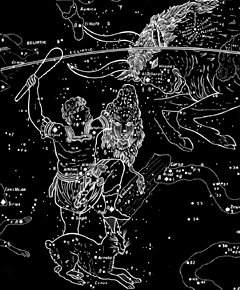
|
|
Orion, the mighty hunter. Before he was set in the stars as a
constellation,
Orion was a
titan,
one of the giants of the antediluvian world who had been defeated by the Olympian gods and destroyed by the Flood sent by Zeus.
Orion was a mighty hunter and, as depicted in the constellation, appears to be opposing the onrushing bull Taurus. The bull Taurus
may be symbolic of God, whom Orion, like Nimrod, opposed and fought against. Thus, the true identity of Nimrod may have been
written in the stars all along.
Images compiled from E.W. Bullinger,
The Witness of the Stars
(Grand Rapids:
Kregel Publications, 1967), 125. All rights reserved.
Click
here
for a larger version.
|
|
|
|
|
One of the dark horse candidates for Nimrod that may constitute the most important evidence for fully understanding the character of Nimrod is the constellation of Orion. The ancient Babylonians were world-renowned for their astronomical abilities, believing that their gods were present not only in their cult statues, but also in the Sun, Moon, stars and planets. The ancient Babylonians (and all ancient peoples) looked to the night sky for religious inspiration, as it was there, they believed, that the gods dwelt. The constellations that we know today were invented by these imaginative peoples in ancient times as a mnemonic device to help them remember the stories of their gods, which were literally "written in the stars" by the fertile imaginations of our earliest ancestors. Bullinger explains in his classic,
The Witness of the Stars,
If we turn to history and tradition, we are at once met with the fact that the Twelve Signs [of the Zodiac] are the same, both as to the meaning of their names and as to their order in all the ancient nations of the world. The Chinese, Chaldean and Egyptian records go back to more than 2,000 years b.c. Indeed, the Zodiacs in the Temples of Denderah and Esneh in Egypt, are doubtless copies of Zodiacs still more ancient, which, from internal evidence, must be placed nearly 4000 b.c., when the summer solstice was in Leo. Josephus says ... 'God gave the antediluvians such long life that they might perfect those things which they had invented in astronomy.' Cassini commences his History of Astronomy by saying 'It is impossible to doubt that astronomy was invented from the beginning of the world; history, profane as well as sacred, testifies to this truth.' Nouet, a French astronomer, infers that the Egyptian Astronomy must have risen 5,400 b.c.! Ancient Persian and Arabian traditions ascribe its invention to Adam, Seth, and Enoch. Josephus asserts that it originated in the family of Seth; and he says that the children of Seth, and especially Adam, Seth, and Enoch, that their revelation might not be lost as to the two coming judgments of Water and Fire, made two pillars (one of brick, the other of stone), describing the whole of the predictions of the stars upon them, and in case the brick pillar should be destroyed by the flood, the stone would preserve the revelation.33
According to Bullinger, and others, the constellations were known by the antediluvians, and that knowledge had been passed down from father to son all the way to Noah, who in turn had passed it on to his sons in the world after the Flood. The constellations were used to tell stories that were eternal truths about mankind, particularly his origins and his future destiny. And of the constellations, Orion consistently stood out in the myths and legends of the ancient world:
Orion was the son of Neptune. He was a handsome giant and a
mighty hunter. His father gave him the power of wading through
the depths of the sea, or as others say, of walking on its
surface.
Orion loved Merope, the daughter of Oenopion, king of Chios, and
sought her in marriage. He cleared the island of wild beasts,
and brought the spoils of the chase as presents to his beloved;
but as Oenopion constantly deferred his consent, Orion attempted
to gain possession of the maiden by violence. Her father,
incensed at this conduct, having made Orion drunk, deprived him
of his sight, and cast him out on the sea shore. The blinded
hero followed the sound of the Cyclops' hammer till he reached
Lemnos, and came to the forge of Vulcan, who, taking pity on him,
gave him Kedalion, one of his men, to be his guide to the abode
of the sun. Placing Kedalion on his shoulders, Orion proceeded
to the east, and there meeting the sun-god, was restored to sight
by his beam.
After this he dwelt as a hunter with Diana, with whom he was a
favorite, and it is even said she was about to marry him. Her
brother was highly displeased and often chid her, but to no
purpose. One day, observing Orion wading though the sea with his
head just above the water, Apollo pointed it out to his sister
and maintained that she could not hit that black thing on the
sea. The archer-goddess discharged a shaft with fatal aim. The
waves rolled the dead body of Orion to the land, and bewailing
her fatal error with many tears, Diana placed him among the
stars, where he appears as a giant, with a girdle, sword, lion's
skin, and club. Sirius, his dog, follows him, and the Pleiads
fly before him.34
Orion was a titan, a giant literally four times the size of a normal man, according to some accounts. He was also a mighty hunter who was able to manifest supernatural powers, and was famous all over the ancient world, including Mesopotamia. Regarding his constellation, Bullinger explains, that Orion "is so pictured in the ancient Denderah Zodiac, where we see a man coming forth pointing to the three bright stars (Rigel, Bellatrix, and Betelguez) as his. His name is given as Ha-ga-t, which means this is he who triumphs. The hieroglyphic characters below read Oar. Orion was anciently spelled Oarion, from the Hebrew root [or] which means light. So that Orion means coming forth as light. The ancient Akkadian was Ur-ana, the light of heaven.35 This description fits well with one of the translations of the name "Gilgamesh" — Namra Udu, "shining light", which is where the name "Nimrod" may have derived. It may also be instructive to note that the names of Uruk and Ur, two of the major cities of Mesopotamia over which Nimrod ruled, also contain the word ur, "light", as part of their names.
Some also have pointed out that Ninurta, of the ancient hunter gods, had also been associated with the constellation of Orion, as well as the star Sirius, which they saw as either his bow, or an arrow. van der Toorn explains,
The god's role as a hunter has been corroborated by his association with the star called "arrow" (Sumerian KAK.SI.SA, Akkadian sukudu), i.e., Sirius. The identification of Ninurta with Sirius, the principal star of Canis maior (referred to as "Bow" by the Mesopotamians), may have facilitated the identification of Nimrod with Orion in late antiquity. In Greek mythology, Sirius is known as the dog of Orion, a legendary giant and hunter ... a conflation of traditions could have resulted in the idea that Orion instead of Sirius was the heavenly counterpart of Ninurta/Nimrod. In this connection it is interesting to note that in Syriac Orion is named gabbar, "hero".36
So, not only was Orion a mighty hunter, he was also a gibbor, or mighty warrior. Moreover, the constellation is arranged in the sky in such a way that it appears to be opposing the onrushing bull, the constellation of Taurus. The bull Taurus may be symbolic of God, whom Orion, like Nimrod, opposed and fought against. Thus, the true identity of Nimrod may have been written in the stars all along, where Orion, mighty hunter "before" the Lord could be translated as "in front of", "opposing", or "against" in the sense that Orion is opposing God, rather than somehow working for him. In the same way, the term "antichrist" can mean either "in place of Christ" or "against Christ" — one meaning is merely questionable, whereas the other is clearly more sinister. And since the Hebrew etymology of the word "Nimrod" is actually "we shall rebel", then the sinister "Mighty hunter against the Lord" should become the accepted translation.
Now that we have established that Orion fulfills the description of both "mighty warrior" and "mighty hunter against the Lord", the question remains, how can a constellation begin his kingdom in Shinar, or build cities in Assyria? The key to understanding how Orion answers the Nimrod puzzle so completely is the fact that though Orion did not actually build the cities, those who did rule Shinar and who had built Assyria all worshiped and were inspired by the divine constellation of Orion. And though they had used different names for the constellation, such as Ninurta and Marduk, Orion being a later Greek appelation for the same constellation, in their minds the same constellation ruled the heavens above and the Earth beneath. In that way, though there were many different earthly "Nimrods" who had hunted and warred and built, there was but one heavenly Nimrod that ruled the heaven and Earth, unchanging, for thousands of years.
And there is a fair amount of evidence to support this, in the form of architecture, as was originally discussed in
Part IV
of our
The Riddle of the Sphinx
series. There, we discovered that large buildings, pyramids, and even entire cities may have built in order to give glory to the divine Orion/Nimrod:
One of the prime factors for believing that all of the most ancient megalithic sites around the Mediterranean
were built (or rebuilt) by one man, Nimrod, is their consistent relationships with the stars, particularly the constellation
of Orion. We have already seen in
part three
of our "Riddle of the Sphinx" series that the pyramids were built and laid out in such a way as to duplicate the stars of the
constellation of Orion. Another link to Orion exists, however, in the city of Edessa, in what is now southeastern
Turkey, in the same region as described in the Bible as being where Nimrod built his major cities.
The oldest known name of Edessa was actually Ourhoi (Syriac), Ourhai (Armenian), or
Er Roha (Arabic)37, which is very close to our modern "Orion".
Furthermore, the name of the province of Edessa was originally called Orrheone. Adrian Gilbert explains
in
Magi: The Quest for a Secret Tradition, "Given that there is strong evidence there was an Orion cult at
Edessa, the similarity between the words Orrheonis and Orionis is such as to suggest that it was from here
that the Greek Orion cult had its origins."38
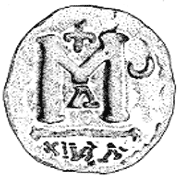
|
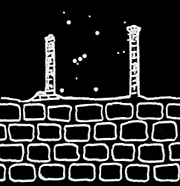
|
|
Top: The pillars of Edessa, on an ancient coin. The pillars are connected
by a central figure surmounted by a cross shape and flanked by the moon. These pillars were closely
linked with the throne of Nimrod/Orion.
Bottom:
An illustration of the pillars, with the constellation of Orion as it would appear to an observer looking south.
Images from
Adrian Gilbert,
Magi: The Quest for a Secret Tradition (London: Bloomsbury Publishing Plc, 1996), 203-204.
|
The city of Edessa is actually closely associated with Nimrod, and is even known as "The Throne of Nimrod" to
this day. There is a prominent set of pillars in the city, which are closely associated with Nimrod's throne,
and which even appear on the coinage of the day. One coin shows a figure standing between the pillars with his
arms outstretched, surrounded by astronomical symbols. Gilbert noticed, when examining the pillars, that when
viewing them from the north, the constellation of Orion passes in between them, just like the figure on the coin.
A set of steps on the southern end of the pillars tends to reinforce the cultic aspect of these pillars, and
they probably served in a late-night ritual wherein the king assumed his throne between the pillars just when
Orion passed between them, symbolically taking on the ancient mantle of authority linked with the constellation.
According to the myths, the Greek Orion (or Oarion) was a son of Poseidon [founder of
Atlantis.
Like Nimrod in the Bible he was a hunter and a giant. He was also exceedingly handsome but, as is so often the case,
this was to lead him into trouble. When, after failing to rid the island of Chios of wild animals, Orion
seduced Merope the daughter of its king, the latter having him blinded as a punishment. An oracle told Orion
that he could have his sight restored if he travelled east and exposed his eyeballs to the rising sun.
Accordingly, he went to the island of Lemnos and there Eos (the dawn goddess) fell in love with him, his sight
being restored by her brother Helios (the Sun).
We can see in the Greek Orion myth a number of parallels with the Egyptian legend of Osiris. The story of
his blinding by the king of Chios echoes the murder of the Egyptian god-king Osiris by his brother Seth, whilst
both Isis and Eos are goddesses associated with the dawn who entreat the Sun-god (Ra/Helios respectively) to
bring Osiris/Orion back to full health. In ancient Egypt the resurrection of Osiris was a matter of profound
religious significance, which seems to have been connected with the annual reappearance of the Orion constellation
at dawn after a period of invisibility. However, Orion can also be "blinded", i.e., his stars become invisible,
when the moon (especially a full moon) passes close by.39
Interestingly, the enthronment of Nimrod appears to be linked with two pillars. Perhaps this is similar to the experience of
Samson, a judge of Israel from the
tribe of Dan,
who was also like Nimrod, being a mighty hunter, warrior, and who also had great strength and supernatural abilities. Samson appeared "between the pillars" of the Philistine temple of Dagon, destroying the Philistines by pushing down those two pillars, which had been critical supports for the temple. Interestingly, like Orion of the Greek myths, Samson had also been blinded by his enemies after having shown inappropriate interest in a woman. Moreover, the lost tribe of Dan is believed by some to be the tribe that would produce the
antichrist,
and Nimrod is generally believed to be a type of the antichrist.
And since by the time of Samson Israel had begun to ignore God's prohibition against intermarrying with the Canaanites, and since the tribe of Dan was the first and most flagrant violator of that law, it is likely that Samson had had one or more
giants
in his family tree — giants that may have descended from the line of giants that Osiris had founded in Mesopotamia thousands of years previously. And Osiris, as we have seen, also was portrayed by the Egyptians as the constellation of Orion. Thus, the clear linkage between Nimrod, Orion, Samson, and Osiris may be the final clues to the true identity of the mysterious Nimrod: Osiris.

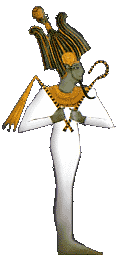
|
|
Osiris, the namesake of the Osirian civilization that Nimrod was attempting to rebuild. Osiris is represented by the
constellation of Orion in Egyptian zodiacs, and may have been the same man as the legendary Nimrod of Mesopotamia known as a great
hunter, conqueror, and builder of cities.
|
Finally, we reach the true source of the Nimrod legend: Osiris, king of Egypt. Osiris, as we saw in
Part I,
was a mighty man of old — a demigod, a giant, a king, a conqueror, and a great civilizer and builder of cities. Furthermore he, like Nimrod, was greatly interested in recovering information from the world before the Flood. And, perhaps most importantly, after he had civilized Egypt, Osiris traveled to other lands, leaving Isis as his regent, to teach other peoples what he taught the Egyptians. This is the key — in ancient times Osiris, traveling throughout the ancient world attempting to civilize mankind, had left behind mighty legends in his wake of a physical, intellectual and spiritual giant of a man who had, in ancient times past, traveled to Mesopotamia and civilized the barbarians that had lived there. Forever afterwards, they looked back to this "Golden Age" when demigods walked the Earth, teaching mankind the arts and sciences and civilization. Izdubar/Gilgamesh may have in fact been Osiris, as the pronunciation of Osiris' name from the original hieroglyphics is actually pronounced "whizzer", very close to "Izdubar".
It is also not a surprise that the first king of united Egypt was named
"Nar-mer",
one of the god-names of
Horus,
which is also very similar to Nimrod. The symbol of Narmer was that of a
catfish
surmounting a chisel.
Though this symbol seems curious at first, it may be an important clue to the origin of Osiris and an ancient line of divine kings who claimed descent from him.
There is a family in Europe named the Merovingians who have descended from a 5th-century king who claimed to have been the offspring of a human mother and a mysterious "beast from the sea": "the mysterious sea beast — the Bistea Neptunis — as symbolically defined in the Merovingian ancestry. The relevant sea-lord was King Pallas, a god of old Arcadia.... The immortal sea-lord was said to be 'ever-incarnate in a dynasty of ancient kings' whose symbol was a fish."40
Thus, the Egyptian hieroglyphics for catfish and chisel that make up Narmer's name may refer to the fact that Narmer was of divine parentage, and the chisel may refer to the fact that he was known as a cutter of stone and, therefore, a builder of cities. Thus, like Nimrod, Narmer was a semi-divine king known for building cities. This makes sense, as Narmer was the king that had unified upper and lower Egypt around 3200 b.c., forming the first nation of the ancient world. Though probably not the king who inspired the legend of Osiris, Narmer was almost certainly of the divine lineage of Osiris, and may well have been the source of the name "Nimrod".
If Osiris did indeed visit Mesopotamia and bring kingship to Kish, we may actually be able to date Osiris to approximately 3500 b.c., around the same time that civilization arose both in Sumer and in Egypt. In both places, architecture and civilization both arose around that time, with fully formed systems of writing, mathematics, astronomy agriculture, and all the lively and technical arts we know today. Archaeologists have long remarked on how suddenly, without any evidence of development over time. John Anthony West says it best in his classic Serpent in the Sky: The High Wisdom of Ancient Egypt:
|
|
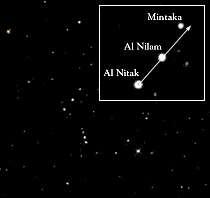
The constellation or Orion. Inset is a closeup of the three belt stars of Orion, with a line drawn through them to show how they are aligned.
|
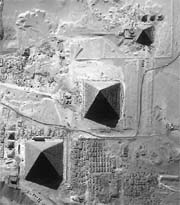
An aerial view of the Pyramids of Giza, which some believe were meant to be an earthly mirror to the belt stars of Orion in heaven. From bottom left to top right: "Great" Pyramid of Khufu, Pyramid of Khafre, Pyramid of Menkaure.
|
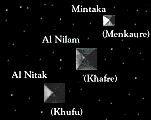
The three main pyramids of Giza, which mirror exactly the three belt stars in the
constellation Orion. Bauval, Hancock and others believe that this was an attempt by the
ancient Egyptians to create a "heaven on earth" in a very real sense.
|
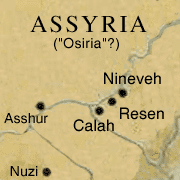
The three cities of Assyria built by Orion/Nimrod, which may also mirror the belt stars of Orion on Earth. It may well be that Nimrod did not
start out in Sumer at all, but in Egypt, where he was known as Osiris.
|
|
|
|
Egyptian science, medicine, mathematics and astronomy were all of an exponentially higher order of refinement and sophistication than modern scholars will acknowledge. The whole of Egyptian civilization was based upon a complete and precise understanding of universal laws. And this profound understanding manifested itself in a consistent, coherent and inter-related system that fused science, art and religion into a single organic Unity. In other words, it was exactly the opposite of what we find in the world today. Moreover, every aspect of Egyptian knowledge seems to have been complete at the very beginning. The sciences, artistic and architectural techniques and the hieroglyphic system show virtually no signs of a period of "development"; indeed, many of the achievements of the earliest dynasties were never surpassed, or even equalled later on. This astonishing fact is readily admitted by orthodox Egyptologists, but the magnitude of the mystery it poses is skillfully understated, while its many implications go unmentioned.41
As we also discussed in
Part IV
of our
The Riddle of the Sphinx
series, Osiris/Nimrod was most likely the builder or rebuilder of the many megalithic structures we find scattered throughout the ancient Near East in his attempt to recreate the world before the Flood, many of which appear to have been built in an attempt to mirror the constellation of Orion on Earth, in the form of architecture:
The namesake of this fabled Osirian Empire was the Egyptian god Osiris, the ancient god of the Egyptians,
who predated most of the gods of Egypt including Re. The origin of Osiris is not clear, though myths of Osiris
abound in Egyptian religion and myth. Childress believes that Osiris was an actual historical person who, like
Gilgamesh of Mesopotamian myth, was given godlike status over time. This man "Osiris" was known all around the
Mediterranean, and examples of his handiwork can be found throughout the Mediterranean and its coasts.
Suddenly, in view of the advanced and ancient civilization in the Mediterranean, the mystery of some of the
awesome and inexplicable sites around the Mediterranean, such as Ba'albek [in Lebanon], does not seem quite
so mysterious after all.... This theory of Ba'albek being some remnant of the Osirian Empire, along with some
of the other megalithic sites in the Mediterranean, fits in well with the Arab legend that the massive stone
blocks were built a short time after the Flood, at the order of the legendary King Nimrod, by a "tribe of
giants." King Nimrod, and Poseidon, are just other names for Osiris of Egyptian mythology.
42
Thus, though Nimrod's kingdom appears in the Bible to have been restricted to Mesopotamia (modern Iraq),
this is unlikely as Cush, his ancestor, was the father of the Kushites, who lived in what is now Ethiopia,
south of Egypt. Similarly, Mizraim, Cush's brother, was the father of the Egyptians (miz rai'm is the
Hebrew name for Egypt - literally, "the two lands", referring to upper and lower Egypt). It is also instructive
to note that the Bible said that the beginning of Nimrod's kingdom was Babylon, indicating that he may
have spread outward from Mesopotamia, spreading out throughout the ancient Mediterranean world building
magnificent structures the likes of which cannot be duplicated even today. And though Nimrod is best remembered by his feats of strength and building of architectural marvels, further study will be required to see what became of his most important legacy to mankind: the line of divine kings that followed after him.
Osiris answers all of the questions that have been nagging commentators for millennia, especially the reference to Nimrod being a descendant of Cush. The Cushites lived in Ethiopia, southern Egypt, northeast Africa and southern Arabia, and some of their descendants may well have emigrated north and east into the land of Shinar. There, they began to rebuild the antediluvian cities of the plain that had been destroyed by the Flood, and then began expanding outwards in their attempt to rebuild and recivilize the Earth as it had been. Osiris is at the right place, at the right time, and of the right lineage to be the fabled Nimrod of old. And forever after, his great exploits were remembered by the ancient Mesopotamians in their myths and legends, and in the stars.




It appears that we are at the end of the chase, and have captured the legendary Nimrod. Osiris, the namesake of this series, was the great civilizer of mankind in and around the Mediterranean region that had been drowned by the Flood. And though it appears that his attempt to rebuild the world before the Flood failed, the great empires of the ancient world fading away and being forgotten, now covered over by a thick and nearly impenetrable layer of Islam, it would be premature to say that Osiris has failed in his attempt to recreate the world before the Flood. The answer to the identity of Nimrod does not lay entirely in the personage of Osiris, or in the constellation of Orion, which remembers him. The third leg in the triune identity of Nimrod is the legacy of kings that he left behind him — kings that claimed that the royal blood of Nimrod flowed in their veins, giving them the divine right of rulership over mankind. And this line of kings may not be broken; some believe that one of this line may arise in the end to reconquer the land of Shinar, in a quest to conquer the world and restore the world to the way it had been before the Flood, when semi-divine kings ruled over a world enslaved. At that time a Nimrod will arise and believe himself to be wise — but in the end, he will be shown to be only a prince of fools.

Part I: The Athenian Empire
|
Part II: Antediluvian Egypt
|
Part IV: Beast from the Sea
King Nimrod
|
Who Was Nimrod?
|
Nimrod Hunting
Osiria Links
|
Osiria Books
|
Osiria Audio
|
Osiria DVD
Editorial
|
Press Releases
|
Book Reviews
|
Fragments
Grand Canyon I
|
Giants III
|
Osiria III
Register
for our new Hall of Records Newsletter!
Questions? Comments? Suggestions? Advertising? Press Releases?
Contact us!

1
A. Leo Oppenheim, trans, "The Sumerian King List"
in James B. Pritchard, ed.,
Ancient Near Eastern Texts Relating to the Old Testament with Supplement
(Princeton, NJ: Princeton University Press, 1974), 265-266.
2
J.B. Tannehill,
Naamah and Nimrod: A Defense of the Faith of our Fathers
(Columbus, OH: The New Franklin Printing Co., 1916), 314.
3
Richard S. Hess, David Toshio Tsumura, eds.,
"I Studied Inscriptions from Before the Flood":
Ancient Near Eastern, Literary, and Linguistic Approaches to Genesis 1-11
(Winona Lake, IN: Eisenbrauns, Dec. 1994).
4
Tannehill,
Naamah and Nimrod, 86-87.
5
P. Ant. Deimel, "Shumer = Shinar" Biblica 2 (1921), 71-74.
6
A.S. Yahuda, "Calneh in Shinar" Journal of Biblical Literature 65 (1946), 325-327.
7
K. van der Toorn and P.W. van der Horst, "Nimrod before and after the Bible" Harvard Theological Review 83:1 (1990), 1-2.
8
"Book 2: Parables (Chap. 69)" in
The Book of Enoch,
translated from the Ethiopian by
R.H. Charles. (Academy for Ancient Texts: http://www.ancienttexts.org).
9
"The Sumerians and the Akkadians" in The Encyclopedia of World History, ed. Peter N. Stearns (Bartleby.com: http://www.bartleby.com).
10
Victor P. Hamilton,
The New International Commentary on the Old Testament: The Book of Genesis: Chapters 1-17
(Grand Rapids: Eerdmans, Dec. 1994), 339-340.
11
Gordon J. Wenham,
Word Biblical Commentary: Genesis 1-15
(Waco, TX: Word, 1987), 224.
12
"Calah" in The International Standard Bible Encyclopedia, ed. James Orr (Studylight.org: http://www.studylight.org).
13
van der Toorn, "Nimrod before and after the Bible", 6.
14
"Resen" in The International Standard Bible Encyclopedia, ed. James Orr (Studylight.org: http://www.studylight.org).
15
"Resen" in The International Standard Bible Encyclopedia, ed. James Orr (Studylight.org: http://www.studylight.org).
16
Emil G. Hirsch, M. Seligsohn, Wilhelm Bacher, "Nimrod" in
The Jewish Encyclopedia,
ed. James Orr (JewishEncyclopedia.com: http://www.jewishencyclopedia.com).
17
Hirsch, Seligsohn, Bacher, "Nimrod" in
The Jewish Encyclopedia.
18
"Nimrod (king)"
(Wikipedia, The Free Encyclopedia: http://www.wikipedia.org).
19
Hirsch, Seligsohn, Bacher, "Nimrod" in
The Jewish Encyclopedia.
20
van der Toorn, "Nimrod before and after the Bible", 6.
21
van der Toorn, "Nimrod before and after the Bible", 10-11.
22
van der Toorn, "Nimrod before and after the Bible", 15.
23
Hirsch, Seligsohn, Bacher, "Nimrod" in
The Jewish Encyclopedia.
24
van der Toorn, "Nimrod before and after the Bible", 10.
25
Oppenheim, "The Sumerian King List", 265-266.
26
Hirsch, Seligsohn, Bacher, "The Epic of Gilgamesh" (Academy for Ancient Texts: http://www.ancienttexts.org).
27
George Smith,
The Chaldean Account of Genesis
(New York: Charles Scribner's Sons, 1986), 184, 191.
28
Robert A. Guisepi and F. Roy Williams, "The Legend of Sargon" (The International History Project: http://ragz-international.com).
29
Yigal Levin, "Nimrod the Mighty, King of Kish, King of Sumer and Akkad" Vetus Testamentum 52:3 (2002), 360.
30
Hirsch, Seligsohn, Bacher, "Nimrod" in
The Jewish Encyclopedia.
31
Samuel Noah Kramer, trans, "Lamentation over the Destruction of Ur"
in James B. Pritchard, ed.,
Ancient Near Eastern Texts Relating to the Old Testament with Supplement
(Princeton, NJ: Princeton University Press, 1974), 455-463.
32
E. A. Speiser, "In Search of Nimrod" Eretz Israel 5 (1958), 34.
33
E.W. Bullinger,
The Witness of the Stars
(Grand Rapids: Kregel, 1967), 9-10.
34
"Orion" (Mythology Guide: http://www.online-mythology.com).
35
Bullinger,
The Witness of the Stars, 125.
36
van der Toorn, "Nimrod before and after the Bible", 11.
37
S. Vailhe, "Edessa" in The Catholic Encyclopedia Online
(The Catholic Encyclopedia Online:
www.newadvent.org/cathen/).
38
Adrian Gilbert,
Magi: The Quest for a Secret Tradition
(London: Bloomsbury Publishing Plc, 1996), 209.
39
Gilbert,
Magi: The Quest for a Secret Tradition, 207.
40
"THE MEROVINGIAN DYNASTY: Bloodline of Jesus or Synagogue of Satan?"
(Watch Unto Prayer:
http://watch.pair.com).
41
John Anthony West,
Serpent in the Sky: The High Wisdom of Ancient Egypt
(Wheaton, IL: Quest Books, 1993), 1.
42
David Hatcher Childress,
Lost Cities and Ancient Mysteries of Africa & Arabia (Kempton, IL: Adventures Unlimited Press, 1997), 25-26.




 Jewish Encyclopedia: Nimrod
Jewish Encyclopedia: Nimrod
 Catholic Encyclopedia: Nemrod
Catholic Encyclopedia: Nemrod
 Wikipedia: Nimrod
Wikipedia: Nimrod
 StudyLight.org: (International Standard Bible Encyclopedia) Nimrod
StudyLight.org: (International Standard Bible Encyclopedia) Nimrod
 StudyLight.org: (Easton's Bible Dictionary) Nimrod
StudyLight.org: (Easton's Bible Dictionary) Nimrod
 StudyLight.org: (Smith's Bible Dictionary) Nimrod
StudyLight.org: (Smith's Bible Dictionary) Nimrod
 StudyLight.org: (Holman Bible Dictionary) Nimrod
StudyLight.org: (Holman Bible Dictionary) Nimrod
 StudyLight.org: (ATS Bible Dictionary) Nimrod
StudyLight.org: (ATS Bible Dictionary) Nimrod
 StudyLight.org: (Hitchcock's Bible Names) Nimrod
StudyLight.org: (Hitchcock's Bible Names) Nimrod
 StudyLight.org: (The Old Testament Hebrew Lexicon) Nimrod
StudyLight.org: (The Old Testament Hebrew Lexicon) Nimrod
 StudyLight.org: Hebrew and Greek Fonts (Windows)
StudyLight.org: Hebrew and Greek Fonts (Windows)
 StudyLight.org: Hebrew and Greek Fonts (Mac)
StudyLight.org: Hebrew and Greek Fonts (Mac)
 StudyLight.org: Hebrew and Greek Fonts (Linux)
StudyLight.org: Hebrew and Greek Fonts (Linux)
 Bible Tools: (Forerunner Commentary) Nimrod
Bible Tools: (Forerunner Commentary) Nimrod
 Bible Facts: Nimrod
Bible Facts: Nimrod
 The Two Babylons
The Two Babylons
 The Dream of King Nimrod
The Dream of King Nimrod
 Providence Baptist Ministries: Nimrod
Providence Baptist Ministries: Nimrod
 Caveman Art: Nimrod, the Mighty Hunter
Caveman Art: Nimrod, the Mighty Hunter
 The Contender: Reading between the Lines: Nimrod
The Contender: Reading between the Lines: Nimrod
 Genesis: Nephilim, Dominance and Liberty
Genesis: Nephilim, Dominance and Liberty
 Rumor Mill News
Rumor Mill News
M E S O P O T A M I A:
 Internet Ancient History Sourcebook: Mesopotamia
Internet Ancient History Sourcebook: Mesopotamia
 Internet Ancient History Sourcebook: Mesopotamia
Internet Ancient History Sourcebook: Mesopotamia
 The Birth Of Civilization
The Birth Of Civilization
 The Metropolitan Museum of Art: The Art of the First Cities
The Metropolitan Museum of Art: The Art of the First Cities
 Bible History Resources: Ancient Near East Resources
Bible History Resources: Ancient Near East Resources
 Fairfield University: Architectural Marvels of Ancient Mesopotamia
Fairfield University: Architectural Marvels of Ancient Mesopotamia
 University of Texas: Images of the Ancient World
University of Texas: Images of the Ancient World
 Routledge: Maps of Ancient Mesopotamia
Routledge: Maps of Ancient Mesopotamia
 K.C. Hanson: Photo Gallery of Ancient Mesopotamia
K.C. Hanson: Photo Gallery of Ancient Mesopotamia
B A B Y L O N:
 Encyclopedia of the Orient: Babylon
Encyclopedia of the Orient: Babylon
 Gateways to Babylon
Gateways to Babylon
 BibleWorld: Babylon
BibleWorld: Babylon
 Iraq GenWeb Official Website
Iraq GenWeb Official Website
 The Threat to World Heritage in Iraq
The Threat to World Heritage in Iraq
 Mojo's Website: Central Iraq - near Babylon and Kerbala
Mojo's Website: Central Iraq - near Babylon and Kerbala
 Barnabas Fund
Barnabas Fund
A K K A D / A S S Y R I A:
 The Ziggurat of Assur
The Ziggurat of Assur
 Nimrud
Nimrud
 Dabar.org: Assyria
Dabar.org: Assyria
 Birs Nimrud - The Hill of Nimrod
Birs Nimrud - The Hill of Nimrod
 UC Oriential Institute: Borsippa (Birs Nimrud)
UC Oriential Institute: Borsippa (Birs Nimrud)
 The British Museum: Nimrud
The British Museum: Nimrud
 Bible Tutor: Places: Assyria
Bible Tutor: Places: Assyria
 Assyrian American Association of Modesto, California
Assyrian American Association of Modesto, California
D E I T I E S & D E M I G O D S:
 About.com: Ancient/Classical History
About.com: Ancient/Classical History
Marduk:
 Wikipedia: Marduk
Wikipedia: Marduk
 Gateways to Babylon: Marduk
Gateways to Babylon: Marduk
 Gateways to Babylon: Tiamat
Gateways to Babylon: Tiamat
 Ziggurat of Marduk (Tower of Babel)
Ziggurat of Marduk (Tower of Babel)
 Esagila (Temple of Marduk)
Esagila (Temple of Marduk)
 The Assyro-Babylonian Mythology FAQ version 1.9html
The Assyro-Babylonian Mythology FAQ version 1.9html
 Nimrod, Mars and the Marduk Connection
Nimrod, Mars and the Marduk Connection
Gilgamesh:
 The International History Project: Gilgamesh
The International History Project: Gilgamesh
 WSU World Civilizations: Gilgamesh
WSU World Civilizations: Gilgamesh
 Cylinder Seal depicting the Epic of Gilgamish
Cylinder Seal depicting the Epic of Gilgamish
 Academy for Ancient Texts: The Epic of Gilgamesh
Academy for Ancient Texts: The Epic of Gilgamesh
 The Epic of Gilgamesh: A Musical Interpretation
The Epic of Gilgamesh: A Musical Interpretation
 The Epic of Gilgamesh: A Musical Interpretation (Purchase)
The Epic of Gilgamesh: A Musical Interpretation (Purchase)
Osiris:
 EgyptianMyths.net: Osiris
EgyptianMyths.net: Osiris
 University of Colorado: Osiris
University of Colorado: Osiris
 EgyptianMyths.net: The Story of Isis and Osiris
EgyptianMyths.net: The Story of Isis and Osiris
 TourEgypt.net: Osiris, Asar
TourEgypt.net: Osiris, Asar
 Ohio State University: Osiris
Ohio State University: Osiris
Orion:
 Nimrod as Constellation of Orion
Nimrod as Constellation of Orion
 Wikipedia: Orion (mythology)
Wikipedia: Orion (mythology)
 The Mythology of the Constellations: Orion, the Hunter
The Mythology of the Constellations: Orion, the Hunter
 Mythology Guide: Orion
Mythology Guide: Orion
 Theoi Project: Orion
Theoi Project: Orion
 Orion (the Constellation)
Orion (the Constellation)
 Lexiline: Sumerian Sky Map of Nineveh
Lexiline: Sumerian Sky Map of Nineveh
 The Celestial Sphinx, a Sumerian Cylinder-seal and the Place of Purification
The Celestial Sphinx, a Sumerian Cylinder-seal and the Place of Purification
K I N G S & H E R O E S
Sargon:
 The University of California: The Akkadian Empire
The University of California: The Akkadian Empire
 Ragz-International: Sargon the Great
Ragz-International: Sargon the Great
 Encyclopedia of the Orient: Sargon
Encyclopedia of the Orient: Sargon
 USAF: The Armies of Sumer and Akkad, 3500-2200 BC
USAF: The Armies of Sumer and Akkad, 3500-2200 BC
Shamshi-Adad:
 Stela of Shamshi-Adad V
Stela of Shamshi-Adad V
T R A V E L:
 Visiting Mesopotamia - Iraq, the cradle of civilization
Visiting Mesopotamia - Iraq, the cradle of civilization
 Picture Iraq
Picture Iraq
 Bet-Nahrain, Inc.
Bet-Nahrain, Inc.
 The Virtual Babel Encyclopedia
The Virtual Babel Encyclopedia
 Photoseek: Nemrut Mountain
Photoseek: Nemrut Mountain
 To My Turkey: Nemrut Dagi (Mt. Nimrod)
To My Turkey: Nemrut Dagi (Mt. Nimrod)
 Turkey Travel Planner: Nemrut Dagi, Eastern Turkey
Turkey Travel Planner: Nemrut Dagi, Eastern Turkey


 Ancient Iraq
Ancient Iraq
Georges Roux
Rating: 




Until the middle of the nineteenth century there was little evidence of the great civilizations that flourished for over three thousand years between the Tigris and the Euphrates, apart from a few allusions in the Bible. Almost every trace of the arts, sciences and literature of the Sumerians, Akkadians, Babylonians and Assyrians was obliterated, hidden under thousands of artificial mounds or tells representing ancient cities. Over the last hundred of years, however, archaeologists of various origins have sought to uncover the monuments and texts that reveal the history and civilization of the region known as Mesopotamia, most of which corresponds to the territory of modern Iraq. In the last three decades, perhaps no other country has been so extensively explored by archaeologists from all over the world and by the Iraqis themselves, while new texts have been published and older texts retranslated or reinterpreted by international teams of Sumerologists and Assyriologists. Newly revised and now in its third edition, Ancient Iraq covers the political, cultural and socio-economic history of Mesopotamia from the days of prehistory to the Christian era and somewhat beyond. Dr. Roux describes for the general public and students the empires that have successively arisen and collapsed in Mesopotamia as well as the institutions, religions, sciences and daily life of its inhabitants. That so vast a subject makes such absorbing reading is due not only to the inevitable fascination of the past but also to the light, yet exact, touch of a talented historian. (From the back cover)
Click
here
to buy this book.
 Babylon (Ancient Peoples and Places)
Babylon (Ancient Peoples and Places)
Joan Oates
"Bablyon the Great, Mother of Harlots and of the Abominations of the Earth": it is not easy for us to efface the lurid vision of Babylon conjured up by the author of the "Book of Revelations". But what is the true story of this ancient city, renowned for its Hanging Gardens — one of the Seven Wonders of the Ancient World — and notorious for the Jewish exile? In a highly acclaimed account, Dr. Oates describes the rise of Babylon from Sargon of Agade to Hammurapi, the great law-giver under whom in the 18th century b.c. the city first attained pre-eminence. She charts its progress under his successors, its greatest period of empire during the reigns of Nebuchadrezzar and Nabonidus in the 6th century b.c. and its decay and final abandonment as Persians and Greeks turned Mesopotamia into a battleground.
(From the back cover)
Click
here
to buy this book.
 Myths from Mesopotamia: Creation, the Flood, Gilgamesh, and Others (Oxford World's Classics)
Myths from Mesopotamia: Creation, the Flood, Gilgamesh, and Others (Oxford World's Classics)
Stephanie Dalley (Editor), C. J. Fordyce
These tales from the ancient civilizations of the "fertile crescent" stand alongside the Odyssey and the Arabian Nights in being popular with an international audience at the dawn of recorded history. Here are myths of the Creation and of the Flood, as well as the fascinating Epic of Gilgamesh, a story of heroic failure in a moment of human weakness. (Review by Amazon.com)
Click
here
to buy this book.
The Sumerian King List
Thorkid Jacobsen
Rating:     
Click
here
to buy this book.
"I Studied Inscriptions from Before the Flood":
Ancient Near Eastern, Literary, and Linguistic Approaches to Genesis 1-11
Richard S. Hess, David Toshio Tsumura (Editor)
Rating:     
Click
here
to buy this book.
 Ancient Near Eastern Texts Relating to the Old Testament with Supplement
Ancient Near Eastern Texts Relating to the Old Testament with Supplement
James B. Pritchard (Editor)
Rating: 




Prichard's ANET is a standard reference for those examining the cultural setting of the Bible. It contains translations of many important inscriptions which shed light on otherwise mysterious Bible customs. Generally regarded as a scholarly work, it's worth checking out for the layperson as well. Some of the jargon may be a little tricky, but there's no substitute for original source material, which makes up the majority of the book. Besides, some of the stories are just a plain old (very old) good read. Included are such things as the Epic of Gilgamesh (containing our oldest Flood parallels), the Nuzi Texts (which help us understand the life of Jacob, among others), and various of the ancient law codes which have parallels to the biblical code. Tremendously useful for study! (Review by Amazon.com)
Click
here
to buy this book.
 The New International Commentary on the Old Testament:
The New International Commentary on the Old Testament:
The Book of Genesis: Chapters 1-17
Victor P. Hamilton
Rating: 




Hamilton's study on the first 17 chapters of the Book of Genesis is part of The New International Commentary on the Old Testament. Like its companion series on the New Testament, this commentary devotes consideable care to achieving a balance between technical information and homiletic-devotional interpretation. (Review by Amazon.com)
Click
here
to buy this book.
 Word Biblical Commentary: Genesis 1-15
Word Biblical Commentary: Genesis 1-15
Gordon J. Wenham
Rating: 




The Word Biblical Commentary delivers the best in biblical scholarship, from the leading scholars of our day who share a commitment to Scripture as divine revelation. This series emphasizes a thorough analysis of textual, linguistic, structural, and theological evidence. The result is judicious and balanced insight into the meanings of the text in the framework of biblical theology. These widely acclaimed commentaries serve as exceptional resources for the professional theologian and instructor, the seminary or university student, the working minister, and everyone concerned with building theological understanding from a solid base of biblical scholarship. (Review by Amazon.com)
Click
here
to buy this book.
Chaldean Account of Genesis
George Smith
Rating:     
1876. Containing description of creation, fall of man, deluge, tower of Babel, times of Patriarchs and Nimrod; Babylonian fables and legends of the gods from cuneiform inscriptions. Contents: discovery of Genesis legends; Babylonian and Assyrian literature; Chaldean legends; Babylonian mythology; Babylonian legend of creation; sin of the god Zu; exploits of Lubara; Babylonian fables; Izdubar legends; destruction of tyrant Humbaba; adventures of Ishtar; illness and wanderings of Izdubar; story of the flood and conclusion.
Click
here
to buy this book.
 Magi: The Quest for a Secret tradition
Magi: The Quest for a Secret tradition
Adrian Gilbert
Rating:
   
It is Gilbert's contention that the Magi were members of a brotherhood that has been guiding civilization for
at least five thousand years, since the time the pyramids were built. At times persecuted, at other times
enjoying the patronage of kings and noblemen, these masters were, and perhaps still are, the custodians of a
a secret initiatory tradition.
Click
here
to buy this book.
 Beyond the Blue Horizon:
Beyond the Blue Horizon:
Myths & Legends of the Sun, Moon, Stars, and Planets (1991)
E.C. Krupp
Rating:
   
Beyond the Blue Horizon is a treasure trove of myths, legends, and stories in which people have, through
the ages, attempted to understand the cosmos and its meaning for humankind. Collecting an astonishing
amount of lore between the covers of a single book, Krupp explains why our ancestors were so intrigued
by the heavens, and what their celestial stories meant. An epic, authoritative, and cross-cultural
exploration with over 150 illustrations, Beyond the Blue Horizon tells how all civilizations searched
the sky to understand the universe - and our place in it.
Click
here
to buy this book.
 NightWatch (1989)
NightWatch (1989)
Terence Dickinson
Dickinson, a renowned writer and former planetarium astronomer teaches you all the
basics to start gazing, including: key facts of stargazing equipment (binoculars and
telescopes), 24 seasonal star charts, "the universe in eleven steps", chapters on the
planets; moon & sun; eclipses; comets, meteors & auroras; photographing the night
sky; and essential resources.
Click
here
to buy this book.
 The Serpent in the Sky:
The Serpent in the Sky:
The High Wisdom of Ancient Egypt
(1993)
John Anthony West
Rating:    
This revised edition of West's revolutionary reinterpretation of the civilization of Egypt
challenges all that has been accepted as dogma concerning this ancient and enigmatic
land. It features a new introduction linking Egyptian science with the perennial wisdom
tradition and an appendix updating the author's work in redating the Sphinx.
Illustrations.
Click
here
to buy this book.
 Lost Cities of Atlantis Ancient Europe & the Mediterranean
Lost Cities of Atlantis Ancient Europe & the Mediterranean
(Lost Cities Series)
David Hatcher Childress
Rating:    
One of Childress' popular "Lost Cities" series, Lost Cities of Atlantis Ancient Europe & the Mediterranean covers the region in and around the Mediterranean Sea, with a special emphasis on cities and mysteries submerged beneath the waters of this vast inland sea. Calling himself a "maverick archaeologist", Childress is more of a researcher, historian, travel writer, and general raconteur rather than a a true academic archaeologist, making general observations based upon library research, study of local myths, legends, and personal anecdotes, as well as actual experiences visiting these sites. Childress is part of a growing trend in historical and archaeological studies towards the rise of independent researchers. These independents are men and women who have developed a distrust for "mainstream" academic archaeology, due to the fact that there is increasing evidence that the academic community is dismissing, ignoring, or even suppressing archaeological evidence that does not fit in with their preset theories. As a result, these independents have dismissed academe as largely irrelevant, and have gone out on their own to examine the evidence for themselves, usually at their own time and expense. It was this kind of passionate search for the truth about history and our origins that motivated similar men of the 19th century to develop the science of archaeology, a passion that motivated people of the 20th century like Childress, unsatisfied by the condescending, pat answers of academics, to take matters into their own hands. Now, in the 21st century, a growing chorus of discontentment with the academic archaeological establishment continues to erode their viselike grip on the truth of our origins, and the independents stand poised to wrest the sword of truth from the hands of those who seem only to be concerned about personal power, privilege, and social status. Lost Cities of Atlantis, Ancient Europe & the Mediterranean is a fascinating read, and a good addition to the Lost Cities series. It should make a great traveling companion for anyone traveling in the Mediterranean region, as well as a great read for the armchair archaeologist, or just someone who enjoys ancient history and mysteries.
Click
here
to buy this book.

 Chariots of Fire
Chariots of Fire
[ORIGINAL RECORDING REMASTERED] [IMPORT]
Vangelis
Rating:     
One of the most memorable soundtracks of all time, Vangelis's Academy Award-winning Chariots of Fire is such a landmark, it's become the stuff of parody whenever someone wants to punch a hole through sloppy sentimentality. But just go back to this 1981 film to relive a perfect marriage of image and music. Vangelis captures the heroism, grandeur, and pain of this racing drama, from the opulent main "Titles" theme with its echoing snare drum and piano cadences to the electronically abstract setting of Sir Charles H.H. Parry's choral work, "Jerusalem." Vangelis's score hangs suspended between orchestral lushness and electronic mood, sweetness tempered by the underlying psychological themes of the film. Often forgotten on this album is the extemporaneous title suite that, in the days of LPs, took up the second side of the album. Here, Vangelis explores some of the film's music cues at length, weaving them into a minor keyboard symphony.
Click
here
to buy this book.
 The Epic of Gilgamesh
The Epic of Gilgamesh
Tony Garone
Rating:    
So what exactly is all this about? What does Ian Anderson (the singer/flautist/leader of Jethro Tull) have to do with "The Epic of Gilgamesh" and insignificant little Tony Garone? On September 11th, 2003, I received a rather cryptic email from my close friend John Sergio (who played bass and Tin whistle on "Utnapishtim and the Great Flood"). It was entitled, "DO THIS". Its only content was this link: (Click
here
to read the full story
Click
here
to buy this CD.
 Beauty in the Beast
Beauty in the Beast
Wendy Carlos
Rating:     
From the roar of Tibetan horns and the clangor of metal percussion that opens Beauty in the Beast, Wendy Carlos in 1986 signaled a new direction for her music. Beauty in the Beast is Carlos's magnum opus, an album that should have established the synthesizer's role in the new global music landscape. More than that, it should have established Carlos as a composer and not just a Switched-on Bach jukebox. But not too many people were listening. Rereleased now after 14 years, Beauty in the Beast has lost none of its power. Carlos is both profound and poignant, dissonant and disarming on Beauty, as she fuses a global orchestra from her synthesizers. "Poem for Bali" is the centerpiece of the album, an episodic, 17-minute excursion as Carlos orchestrates the sounds and rhythms of a digital gamelan orchestra. In addition to replicating the metallophones, gongs, and flutes of the traditional gamelan, she creates her own hybrid sound designs, giving this work a surreal and sometimes harrowing tone, like a dream bent through funhouse mirrors. But then there are pieces such as "A Woman's Song," based on a Balkan melody. The title track merges nightmare landscapes and a crazed carnival calliope with a haunting theme that sounds like a lament for the end of the world. Beauty in the Beast is an essential recording of both modern composition and synthesis--Carlos should plug into this circuit again.
Click
here
to buy this book.
 Gladiator: Music from the Motion Picture
Gladiator: Music from the Motion Picture
Hans Zimmer, Lisa Gerrard
Rating:     
Most modern Hollywood films have musical "temp tracks" laid in as they're edited, usually classical standards or music from other soundtracks that helps shape the dramatic and emotional intentions of works in progress. Sometimes these temp tracks become the score (as in "2001"), but more often they serve as a template for the film's eventual scorer. That said, we'll boldly climb out on a limb and opine that director Ridley Scott was listening to a whole lot of Holst's The Planets as he was cobbling together his modern gladiator epic. Credit Hans Zimmer for taking "Mars, the Bringer of War" and hammering its familiar harmonic and rhythmic Sturm und Drang into something serviceably fresh; cohort Lisa Gerrard generally handles the more ethereal, atmospheric passages. As epic in scope as its thematic inspiration (and with enough occasional nods to "authenticity" to make it work), this is nonetheless a work of often surprising nuances, and one that recasts the traditional heroic orchestral score in deliciously dark and ominous tones. Warning: repeated listening may inspire the invasion of neighboring countries.
Click
here
to buy this book.
 More Music from the Motion Picture Gladiator
More Music from the Motion Picture Gladiator
Hans Zimmer, Lisa Gerrard
Rating:     
If there's one thing film producers and record executives like more than Success, it's Success: Part 2. Thus when Ridley Scott's high-tech sword 'n' sandal epic scored both Golden Globe wins and Academy Award nods for Best Film and Best Score, it was a sure bet that another volume of Hans Zimmer's and Lisa Gerrard's music for the film couldn't be far behind. Though not exactly leftovers, the tracks here sometimes point to the fact that there wasn't enough fresh material to fill this volume out, hence we get some remixed cues, a handful of familiar music with dramatic dialog excerpts edited and superimposed (or misplaced, with decidedly mixed results), and even a beat-heavy, dance-club mix of "Now We Are Free." With a little over half an hour of entirely fresh material and some souvenir dialog snippets over the rest, there's enough here to please Gladiator die-hards. Also of note: guitarist Heitor Pereira's flamenco-flavored flourishes are better showcased throughout; and "The Gladiator Waltz" serves up one of Zimmer's original synth demos (with a dash of Russell Crowe dialog up front)--a dramatic amp-up of Holst's "Mars, the Bringer of War" that's a prime example of the composer's state-of-the-art digital orchestral conjuring.
Click
here
to buy this book.

 Mysteries of the Bible
Mysteries of the Bible
(A&E)
Rating:
   
The Bible is the equivalent of a treasure map in this archeological edition of A&E's Mysteries of the Bible series. Both contemporary scientists and those from the last century have taken their cues from the scriptures when digging, leading to excavation of the 3,000-year-old remains of the towns of Beersheba and Capernaum. Also, there are accidental finds like a shepherd's 1947 discovery of the Dead Sea Scrolls in a cave. This 45-minute tape, narrated by Richard Kiley, examines the relationship between archaeology and the Bible, illuminating such personalities as Sir William Flinders Petrie, whose ballerina attire convinced the Egyptians it would be harmless to let him measure the pyramids. The husband-and-wife team of Eric and Carol Meyers explain how their work on the Masada both confirms and contradicts the only contemporaneous historical account of the siege and mass suicide there. Finally, there's a good example of technology at work: electromagnetic images eliminate random digging, computer models graphically resurrect ancient Jerusalem.
Click
here
to buy this DVD.
 Charlton Heston Presents the Bible: Genesis
Charlton Heston Presents the Bible: Genesis
(1993)
Rating:
    
In the beginning� before there was a written language, the stories in the Bible were told, to people sitting around a campfire in the dark, listening to the tales of what had happened and what was yet to come. Now, Academy Award-winning actor Charlton Heston (Ben-Hur) recaptures all the passion, the power, the drama, and the sheer beauty those first storytellers passed on to us with his own dazzling new exploration of the greatest stories ever told.
In Part One, Genesis, Mr. Heston recounts the origins of man and the universe from the stark beauty of a recently discovered Roman amphitheater at Beit She'an, Israel. Here is all the wonder of the Creation� the forming of Adam and Eve� the choice of the Tree of Knowledge and the loss of Eden. Here, too, is the dramatic story of Cain and Abel� the awesome power of God's wrath with Noah and the Flood� an the testament of faith in the account of Abraham and Isaac.
Shot on location in the Holy Land, this incredible production is more than great literature come to life. It is a walk through history itself.
Click
here
to buy this DVD.
Editorial
|
Press Releases
|
Book Reviews
|
Fragments
Grand Canyon I
|
Giants III
|
Osiria III
Register
for our new Hall of Records Newsletter!
Questions? Comments? Suggestions? Advertising? Press Releases?
Contact us!
|

